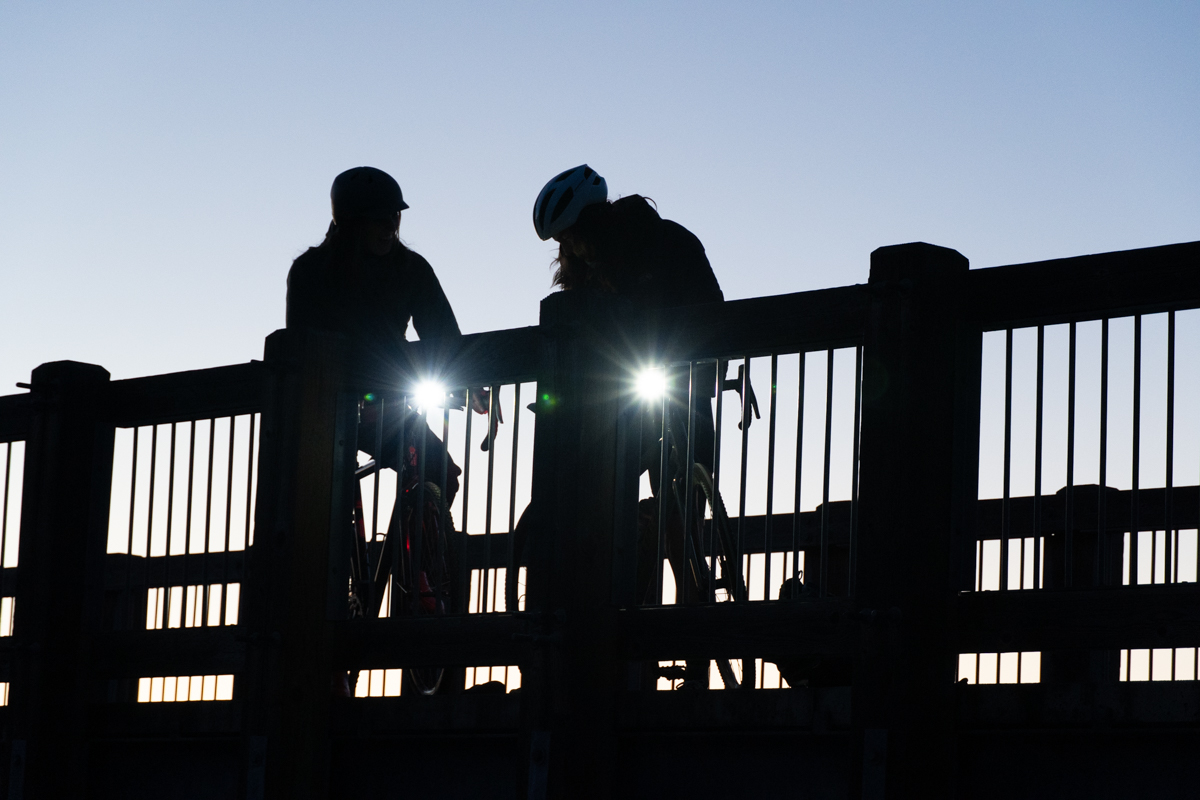
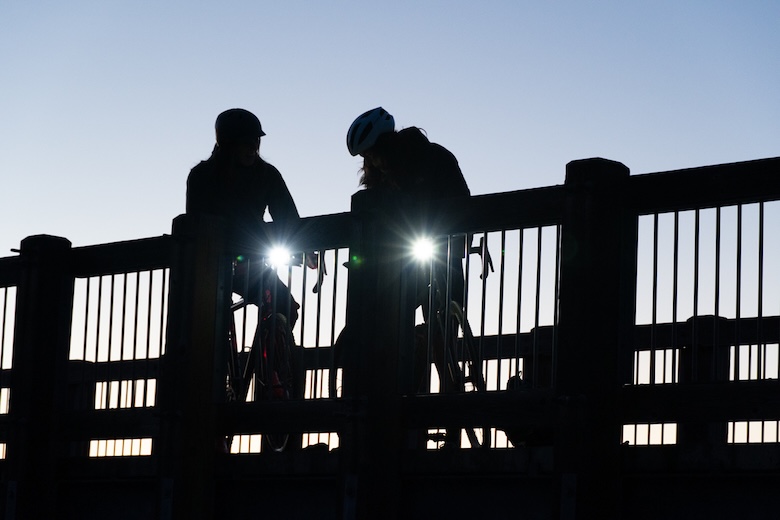
Whether you’re a first-time bike commuter or a dedicated mountain biker, riding at night can be an exhilarating experience. But traveling along dark streets or singletrack at any speed requires a quality light (or two) to illuminate the way. Below we break down our top 15 bike light picks for 2025, which include our favorite headlights, rear lights, and combo light sets from brands like NiteRider, Exposure, Outbound Lighting, Trek, and more. Some models balance the need for both on- and off-road use, while others come with dedicated features for urban riding or serious backcountry pursuits. For more information on our preferred bike lights, see our comparison table and buying advice below the picks, along with details about our team and testing process.
Editor's note: We updated this guide on April 30, 2025 to add new lights to the list after recent testing from brands like Exposure, Knog, and NiteRider. We also adjusted the order of our list following extensive testing, bumping Outbound Lighting's Evo Downhill Package up as our favorite mountain biking option, adding Knog's Blinder Link as our favorite rear bike light, and slotting in NiteRider's Swift 500 in as our favorite budget light. We included some new imagery from testing and ensured all other information was up to date at the time of publishing.
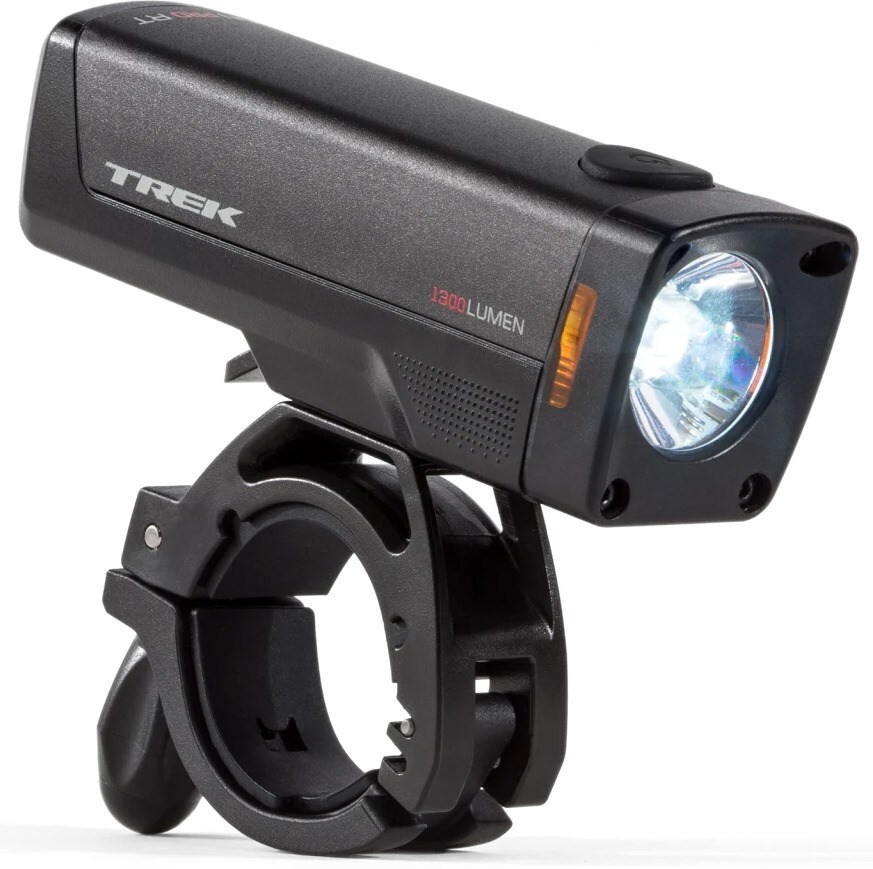 Type: Headlight
Type: Headlight
Max lumens: 1,300
Run time: 1.5–22 hours
What we like: Bright light that’s versatile for both commuting and mountain biking.
What we don’t: Pricey; batteries take a while to recharge and some users have had quality issues with the batteries over time.
With its bright output, quality construction, and modern features that excel both on a road or singletrack, Trek's Ion Pro RT headlight grabs our top spot. The versatility of the design really makes it stand out: Its 1,300-lumen output is great for all types of night riding and its strong, versatile beam nicely balances spot and flood characteristics. We especially like the handlebar mount design, which is easy to install on a variety of bar sizes—thanks to its toolless adjustment—and provides a steady and confidence-inspiring hold What’s more, the Ion can be removed from the clamp without undoing it, and it slips easily into a pocket when you need to stop by the grocery store on the way home. And considering that it’s a one-light solution for everything from your daily commutes to serious mountain bike rides, the Ion Pro’s $140 price tag becomes a bit easier to swallow.
In addition to its well-rounded light performance, the Ion Pro RT has a full suite of useful features. To start, it’s one of the few options in our round-up that supports Bluetooth-equipped devices (like a GPS bike computer), which is great for checking on battery life and adjusting modes on the fly. The Trek also features orange side markers that help you stand out at road crossings, and we found the top light adjustment button easy to toggle on the go. We do prefer the cut-off beam pattern on Outbound Lighting’s Detour (below), but for $45 less, we’ll take the extra time to adjust the Ion Trek properly to not blind oncoming traffic. And if we were to nitpick, this light is a bit heavy to attach to a helmet for rough mountain bike trails and its recharge time is long at 7 hours. Trek is the only company on our list of the best mountain bike brands that also makes a light we recommend. Of note: some users have reported issues with limited battery life, which we are monitoring on our end through prolonged testing; we'll report back if we have a similar experience or any concerns.
See the Trek Ion Pro RT
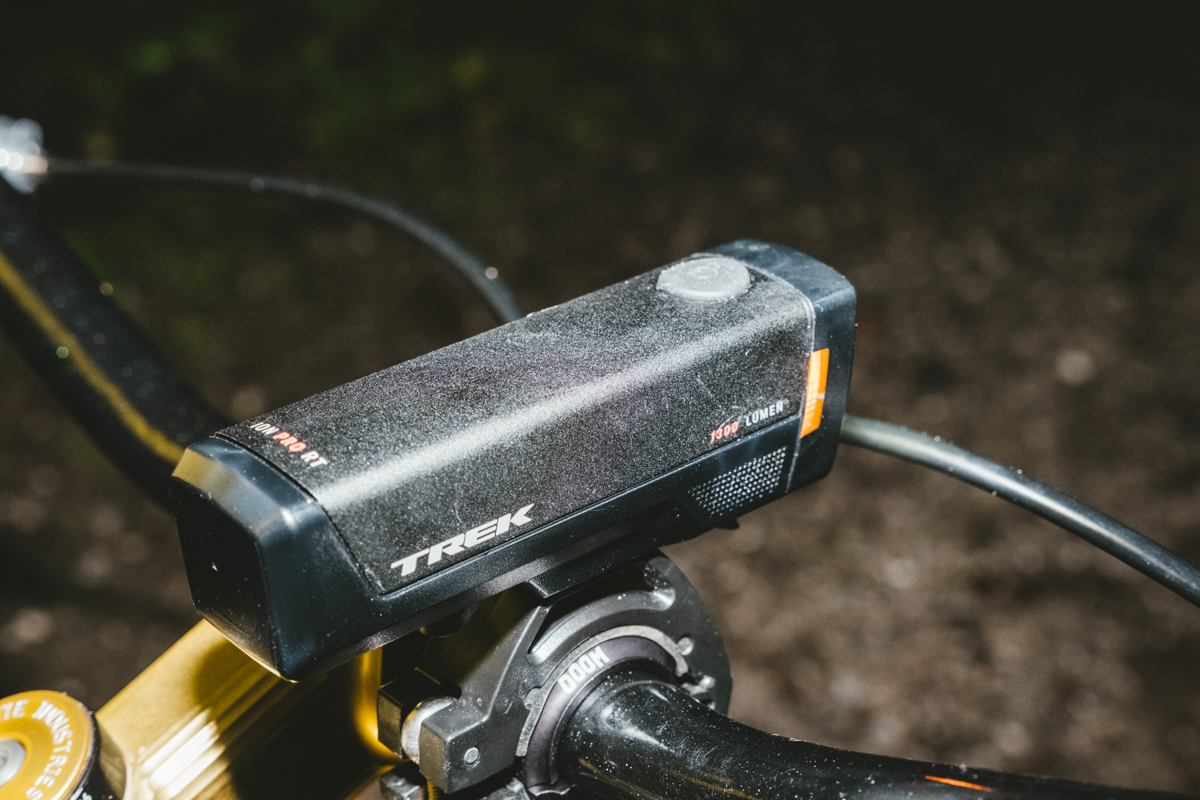
 Type: Headlight
Type: Headlight
Max lumens: 500
Run time: 1.8–32 hours
What we like: Extremely versatile and low price.
What we don’t: Not bright enough for fast and dark night rides.
If you’re just looking for a light that can get you to and from work, or a plan B light to stick in your backpack in the case of emergencies, look no further than NiteRider’s Swift 500. For a reasonable $40, you get a quality 500-lumen beam that lands in between a spot and flood pattern, a rechargeable battery, and the security that comes from a reputable brand. We especially like the unit for its small size that’s easy to throw in a pack, five modes that are simple to swap between, and relatively long battery life (just under 2 hours on high). And for a budget light, the mounting clamp is surprisingly hard-wearing and easy to use. Simply put, it’s an ideal companion for mellow rides or to bring along on grocery runs or dimly lit roads.
Not surprisingly, the Swift 500’s lower output limits its appeal for navigating in pitch black or off-road. As such, we wouldn’t recommend using it as your sole light source for serious nighttime riding. If you want to keep things cheap, but are also looking for a light with a bit more power, NiteRider’s Lumina Micro 900 gives you 400 more lumens for just $35 more. On the other hand, you can certainly go cheaper if you opt for an even dimmer light, such as the Swift 300, but we think the 500 is a better option for just $10 more. You shouldn’t expect any premium tech or elaborate beam patterns here—the Swift 500 is purely utilitarian—but it excels in those “just in case” scenarios when you’re running late, and it’s also a viable option for bikepacking or touring trips.
See the NiteRider Swift 500
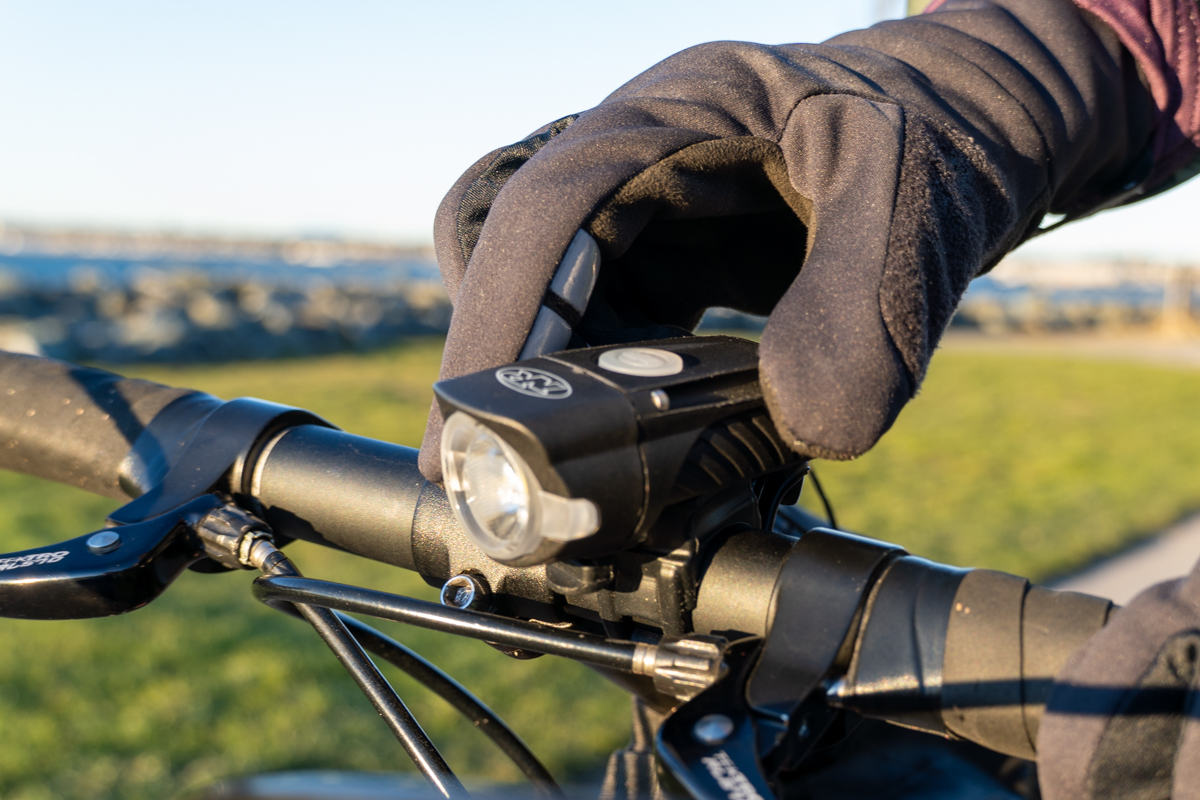
 Type: Rear light
Type: Rear light
Max lumens: 100
Run time: 5–50 hours
What we like: Provides excellent visibility for approaching motorists.
What we don’t: Doesn’t support Bluetooth connections like other options.
Quality tail lights like the Knog Blinder Link can be seen from half a mile away (or more) by oncoming motorists and are a great way to keep you safe during early-morning or late-night commutes. Many choose to go cheap in this category, but we think it’s worth spending up for the $60 Knog Blinder due to its bright light that functions well even on sunny days, its long-lasting build, and the convenient USB-C rechargeable system (many cheap rear lights run only on disposable batteries). Furthermore, the Blinder includes a total of eight different flash and steady-state light modes to make you as visible as possible, as well as a low battery and charge indicator, and an easy-to-install rack mount.
As we touched on above, the Knog is fairly pricey for a rear light. Plenty of cheap options are available, including the $50 Cygolite Hotshot Pro 200 below. We’ll hand it to the Cygolite for its boost in brightness (200 lumens), but the Knog has a longer battery life on its brighter modes (3 hours more than the Cygolite on high). We also think the Knog has a classier style—we really like the svelte rectangular shape—while the Cygolite leans less modern. Appearances aside, we think it’s worth erring on the side of such a well-rounded model, especially with what feels like an ever-increasing number of distracted drivers on the road. And for the ultimate in rear light safety, check out the Garmin Varia RTL515 below, which uses a radar system to alert you to approaching cars.
See the Knog Blinder Link
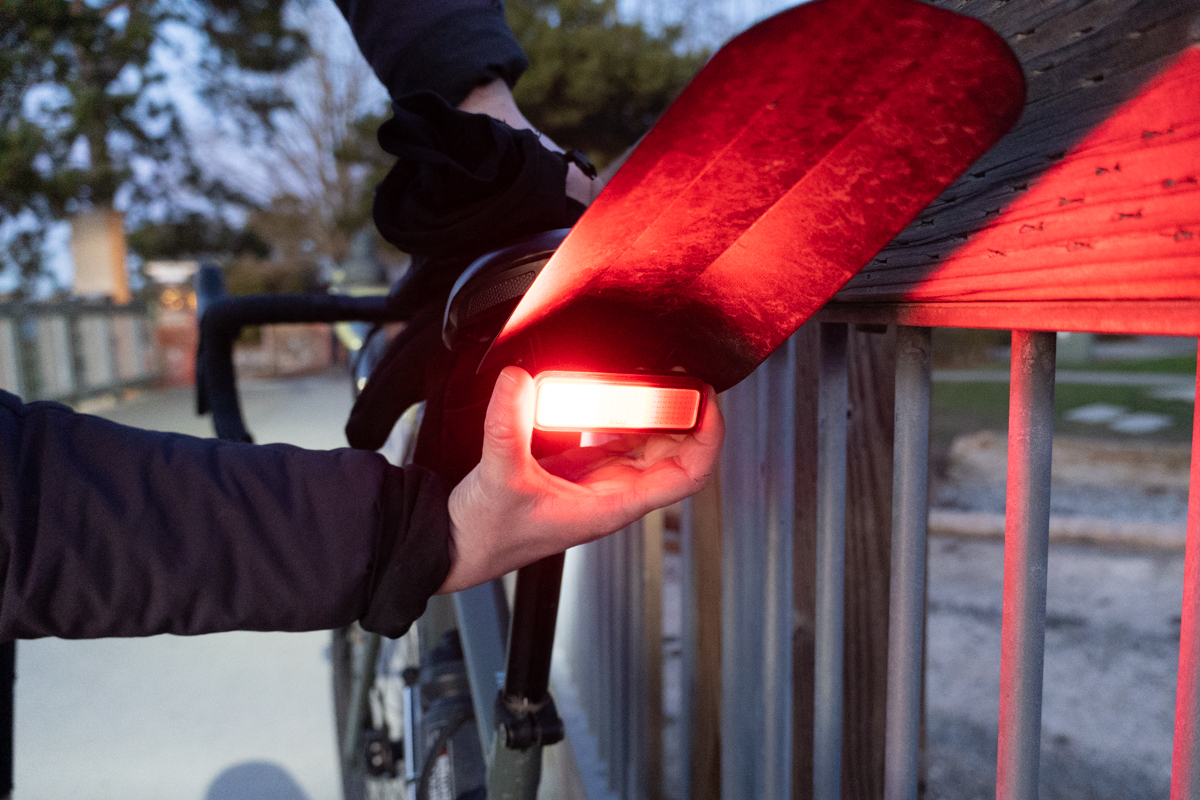
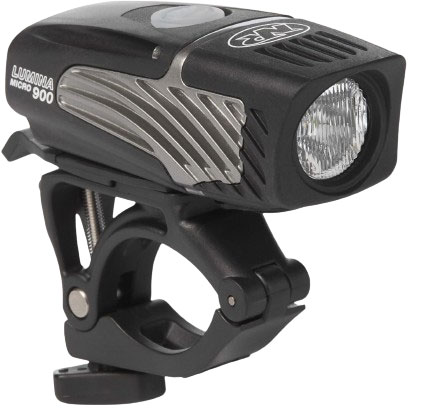 Type: Headlight and rear light set
Type: Headlight and rear light set
Max lumens: 900 (front), 150 (rear)
Run time: 2–60 hours (front), 5.5- 27.5 hours (rear)
What we like: Two quality and proven lights at a great price.
What we don’t: Some high-speed commuters may want a little higher output.
Front and rear light sets simplify the buying process and are a nice way for commuters to maximize bang for their buck. Among the wide range of options, we like NiteRider’s Lumina Micro 900 and Vmax+ 150 set best, which includes two of the brand’s top lights for $105. The bright Lumina Micro headlight has a wide and long beam that we’ve found is more than sufficient for illuminating dark streets at just about any speed. Further, the burly handlebar mount keeps it secure on rough roads or back alleys, and the quick-release attachment system allows you to easily remove the light for charging. And finally, the compact size of the Lumina Micro is great for tossing in your bag on the way into the grocery store or office.
Tail lights are equally important for commuting, and NiteRider’s Vmax+ 150 is a winner. Its six different light modes (four flashing and two solid) are simple to switch between and adjust depending on conditions. And like the Lumina Micro, the Vmax+ includes a handy quick-release function. In terms of batteries, both the front and rear are rechargeable, which helps cut down on battery waste (they’re also quick to recharge at a minimum of 2.5 hours for the Lumina and 2 hours for the Vmax+). All told, this NiteRider set is a reliable and proven choice for year-round commuting.
See the NiteRider Lumina Micro and Vmax+ Set
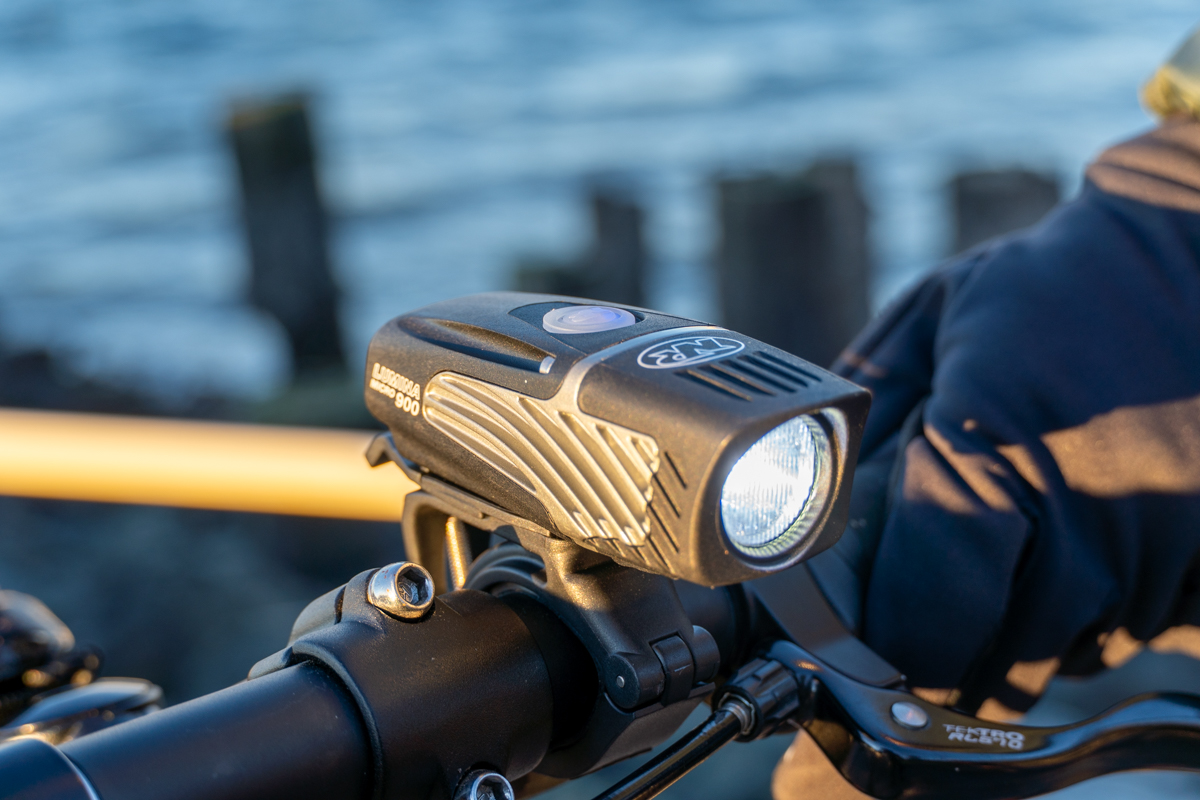
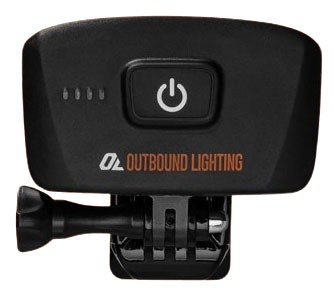 Type: Headlight and helmet set
Type: Headlight and helmet set
Max lumens: 3,200 (combined)
Run time: 1.7-10 hours (front), 1.1-6.5 hours (helmet)
What we like: Great value for a headlight/helmet set; impressive optics.
What we don’t: Battery run times are on the shorter end.
Outbound Lighting is a Chicago-based brand that has garnered quite the following in the mountain biking world for their impressive optics. They’ve taken the mountain biking space by storm with their Evo Downhill package, which consists of the Trail Evo headlight and Hangover helmet light. With 3,200 lumens of combined fast-moving brilliance (2,200 lumens for the Trail Evo and 1,000 lumens for the Hangover), the package is ideal for moving quickly through tricky terrain at night. The Downhill package also ditches the industry-standard cone beam for a super-wide beam that generously lights up the trail ahead. And there's something to be said about the headlight/helmet light combo: Though a mountain bike-specific headlight is great on its own, adding on a helmet light provides even more security when rounding corners and investigating surroundings. Not to mention bang for your buck: This set is $75 less than the NiteRider Pro below.
Overall, there’s a lot we like about this combo: Both lights have simple interfaces, are rechargeable via USB-C or pass-through systems, and have a durable and quality build. Our mountain bike tester also had nothing but good things to say about the mounting system, which is outfitted with a tool-free pivot that makes it easy to aim the light where you want it. The downsides? The Downhill Package doesn’t have a stand-out run time (max of 10 hours for the Evo and 6.5 for the Hangover), and in general, Outbound Lighting products can be tough to find outside of the US, which will be a consideration for those riding abroad (those in Europe should check out UK-based Exposure below). It’s also worth noting that the Trail Evo and Hangover can be purchased separately ($245 and $135, respectively) if you don't want to shell out for the pair.
See the Outbound Lighting Evo Downhill Package
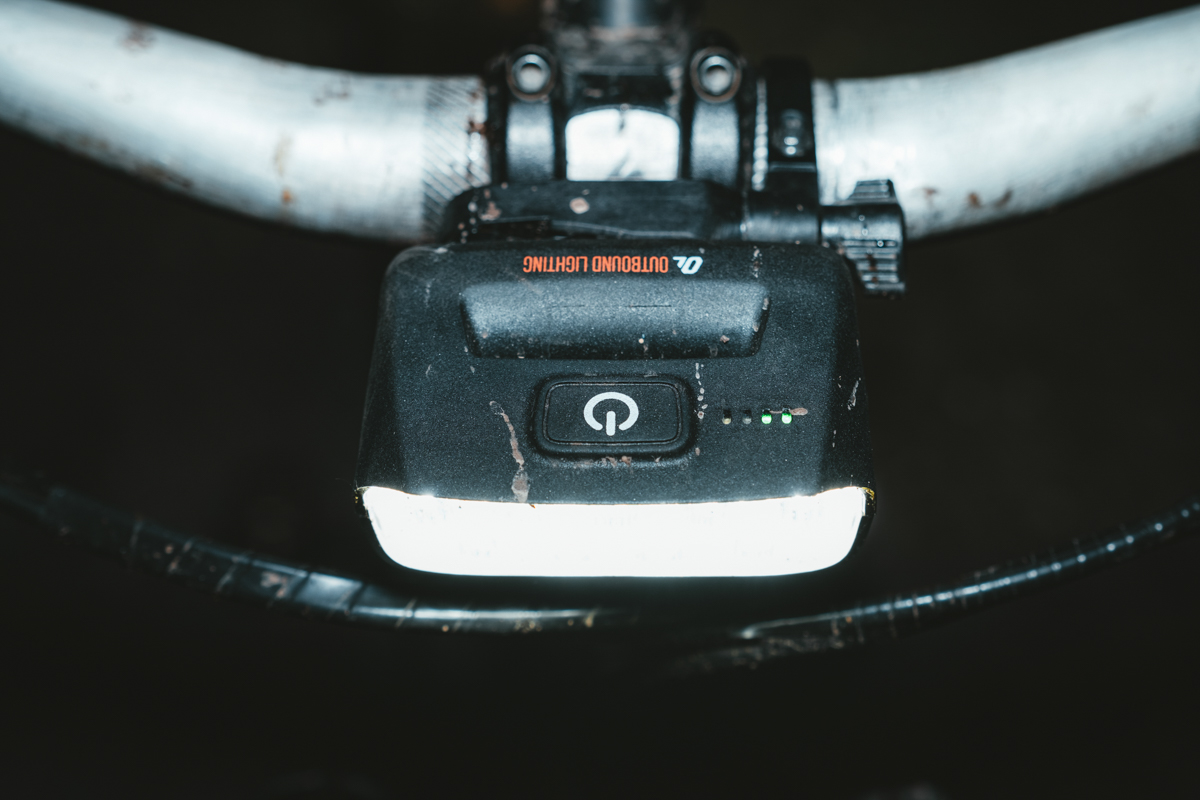
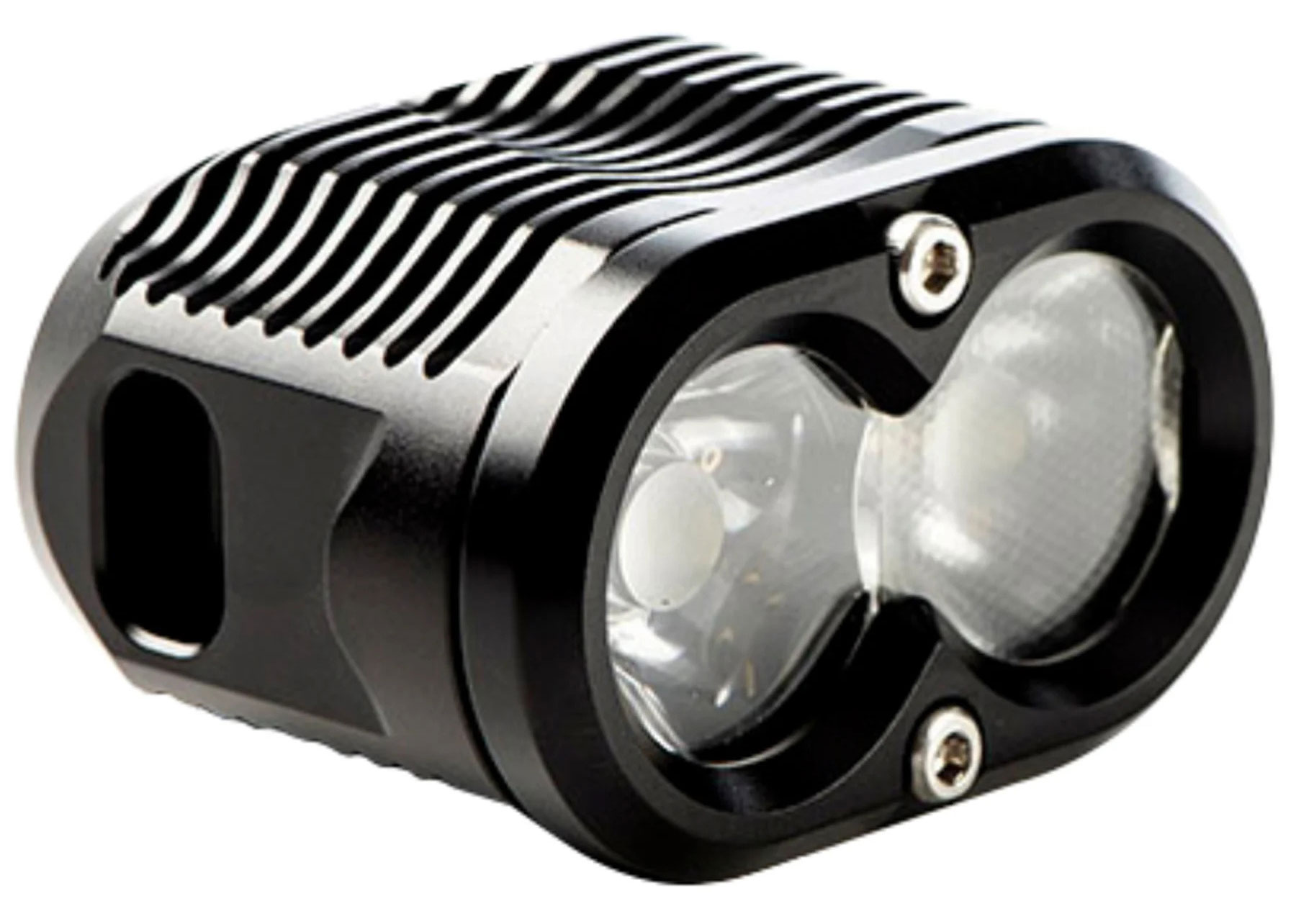
Type: Headlight
Max lumens: 2,000
Run time: 2-8 hours
What we like: A quality light with an excellent beam pattern; includes a wireless remote.
What we don’t: Shorter battery life and expensive.
New Zealand-based Gloworm may not be a household name like NiteRider or Trek, but the company has a dedicated following among hardcore riders. With its excellent track record, quality design, and included set of features, the Gloworm X2 Adventure is one of our top picks for mountain biking. In the box, you’ll find everything you need to get on the trail: helmet and handlebar mounts, a wireless handlebar remote for controlling modes on the fly, a power pack and USB-C charging cord, and a spare lens (to swap between spot and flood beams). Light settings can also be adjusted on the Gloworm app, where you can pre-program brightnesses and determine runtime before setting out for your ride. Furthermore, the X2 will hold up well in wet and rowdy conditions with its IP67 waterproof rating (submersible in 1 meter of water for 30 minutes).
Our main gripe with the Gloworm is battery life. With a run time of just 8 hours on the lowest setting, this light is easily beaten by the 10-hour and 16.5-hour max run times of the Outbound Lighting Trail Evo above and NiteRider Pro 4200 below. However, it's the price tag that compels us to push this light near the top. While $269 certainly isn’t inexpensive, it provides one of the best values on the market when you consider all that’s included. Not only do you get a bright 2,000-lumen light, but the package also includes a wireless remote and multiple lenses. You also get the freedom to customize your light output and runtimes. And while the 4,200-lumen NiteRider Pro is twice as powerful, the Gloworm leaves little to be desired at $181 savings.
See the Gloworm X2 Adventure
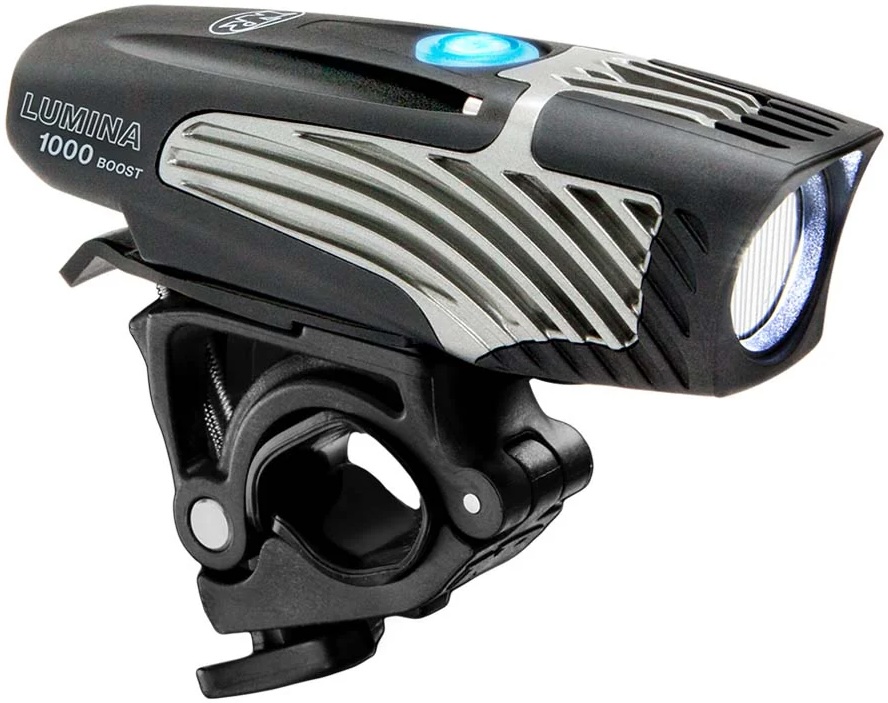 Type: Headlight
Type: Headlight
Max lumens: 1,000
Run time: 1–21 hours
What we like: Strong and versatile at a very competitive price.
What we don’t: Short battery life on high.
NiteRider has arguably the most well-rounded light lineup of any manufacturer, and their venerable Lumina series aims to balance the needs of both road and mountain cyclists. Newer to the Lumina team is the 1000 Boost, a great nighttime road- or trail-riding companion. This light has a max output of 1,000 lumens, six different light modes, and boasts a 21-hour run time on its lowest 50-lumen "walk" setting. Not to mention, its 750-lumen setting lasts almost as long as the Swift 500’s highest lumen setting. The simple design has everything you need and nothing you don’t, including a low battery indicator and rechargeable internal battery (via micro USB). For a few more bells and whistles (and a massive bump in lumen power), check out the Lumina Max 2500 below.
So, what’s not to like about the NiteRider Lumina Pro 1000? If you’ll be doing a fair amount of riding in the rain, the light isn’t the most water-resistant option on this list (it’s rated only for water spray). Further, dedicated mountain bikers will likely find the one-hour runtime on high to be lacking. And although the Pro's thumbscrew mount is efficient, it's less secure than that of the Trek Ion RT above. But the Lumina Pro 1000 easily undercuts the Ion RT in price and is a great option for those who want a compact, affordable, and highly versatile headlight.
See the NiteRider Lumina Pro 1000
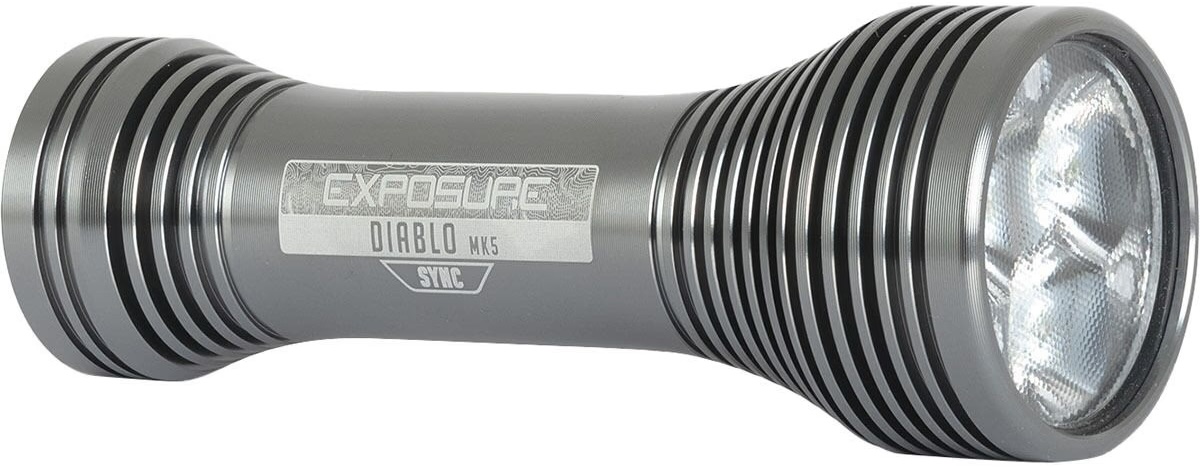 Type: Headlight
Type: Headlight
Max lumens: 2,000
Run time: 1–18 hours
What we like: Truly a premium mountain bike light.
What we don’t: Harder to find outside of Europe and expensive.
Outbound Lighting’s Downhill Package is our top pick for mountain bike lighting, but Exposure’s offerings are a close second. What sets Exposure apart is its exceptional build quality—easily the best on this list. A prime example is the Diablo Sync MK5: this premium aluminum light is purpose-built for aggressive trail riding. It delivers a powerful 2,100-lumen white spot beam that excels in challenging terrain and offers an impressive 24-hour maximum run time—14 hours longer than Outbound’s Trail Evo. Its light modes are easy to cycle through, even when helmet-mounted, and Exposure’s “Sync” technology allows for remote control via the Sync app. Riders can customize settings and control both helmet and handlebar lights simultaneously. Altogether, the Diablo stands out as one of the highest-quality lights on the market, built to last for years.
That said, Exposure does have a few drawbacks. Opposite Outbound, their products can be harder to find in the US. In fact, we tested the Zenith MK3—similar to the Diablo Sync in design and beam technology but with a more powerful battery and higher max output (2,200 lumens)—but ultimately chose to highlight the Diablo here due to its greater availability stateside. US buyers may face high shipping costs or import fees when ordering from Exposure’s UK-based site. In terms of performance, we found the Zenith a bit heavy and cumbersome for helmet use, and its puck-style mounting system was tricky to secure (Outbound’s mount was easier to work with). It's also worth commenting on the price: At $325, the Diablo Sync is the second most expensive light on this list, right behind NiteRider's Pro 4200 Enduro below. Still, if you’re after a premium lighting setup and don’t mind the shipping costs, Exposure is hard to beat.
See the Exposure Diablo Sync MK5
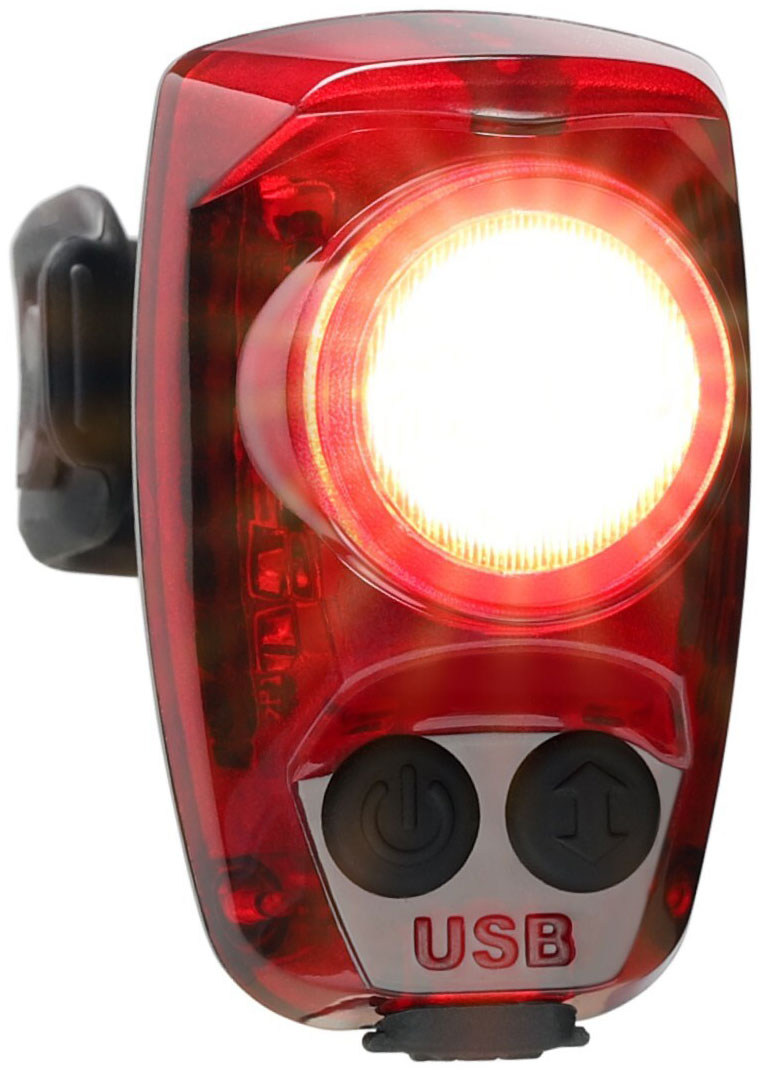 Type: Rear light
Type: Rear light
Max lumens: 200
Run time: 2–210 hours
What we like: A cheaper and brighter rear light than the Knog Blinder above.
What we don’t: Still somewhat expensive.
Knog’s Blinder Link above is our favorite rear bike light, but for $10 less, the Cygolite Hotshot Pro 200 has a lot going for it. While not as streamlined and modern as the Knog, the Hotshot Pro 200 features a brighter light (100 lumens brighter than the Knog), a durable build, and a USB-rechargeable battery. It also has six different light modes—both steady light and flash—to make you visible to approaching traffic. We also prefer its simple strap mounting system to the Knog, though the long-term durability of the rubber is more of a concern.
But let’s be honest, both the Cygolite and Knog are expensive as far as rear lights go. If you really want to keep things within budget, you can opt for the $23 Planet Bike Superflash below, but that light can’t come close to matching the brightness of the Cygolite at only 65 lumens. Further, the Hotshot includes both seat post and seat stay mounts, so you can place it wherever it’s most effective. In the end, you really can’t go wrong with any of the rear light options on this list, but we’ll hand it to the Cygolite for providing a simple yet reliable rear light that’s plenty bright for most situations.
See the Cygolite Hotshot Pro 200
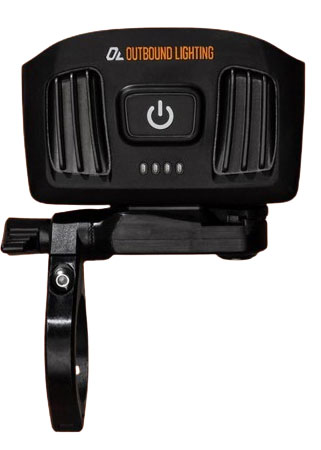 Type: Headlight
Type: Headlight
Max lumens: 1,200
Run time: 1.7–10 hours
What we like: Fantastic optics, simple interface, and quality build.
What we don’t: Run time can't beat the competition; a bit bulky.
Outbound Lighting is well-known in the mountain biking world, but we’d be remiss not to include their road-specific Detour light here. Out of all the road lights on this list, the Detour strikes us as the most thoughtful: Most notably, the Detour features a cutoff beam pattern that focuses light forward and in front of your bike rather than in the trees or the eyes of oncoming traffic. You’ll also notice that the Detour starts your ride off bright and gradually dims as your eyes adjust to the light, providing just enough light to illuminate the road before you while also conserving battery in the long run. This light emits a maximum of 1,200 lumens, has five different modes, and is rechargeable via USB-C or pass-through charging. We enjoy its simple interface and how easy it is to toggle between modes (press the big button to brighten or dim, hold for strobe). All in all, we appreciate the quality of this light— every detail, from optics to build, feels well thought out.
Though few, we do have gripes with this model. For one, its battery life can’t match that of the Ion Pro RT above (a max of 10 hours to the Ion Pro’s 26), which might be a worthy sacrifice considering the quality of the optics, but is nonetheless disappointing considering the $45 jump in price. Some users have also reported a loose mounting system that causes the light to shift while riding, but that hasn’t been an issue in our testing. But if you do face any issues with your light, we’ve had great experiences with Outbound Lighting’s customer support, which is both prompt and informative. All in all, Outbound Lighting’s optics are tough to beat, and we found ourselves reaching for their lights in most cases. We’re excited to put some more miles into this model to see how it holds up in the long term.
See the Outbound Lighting Detour
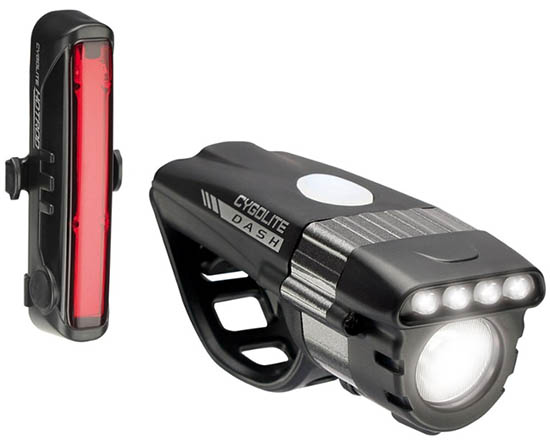 Type: Headlight and rear light set
Type: Headlight and rear light set
Max lumens: 600 (front), 50 (rear)
Run time: 1–70 hours (front), 1.5–100 hours (rear)
What we like: The flashing modes were some of the brightest in our test.
What we don’t: Some might not like the slightly blueish tint of the Dash Pro 600.
Coming in $10 less than the NiteRider set above is the Cygolite Dash Pro 600 and Hotrod 50. Starting with the headlight, the Dash’s 600 lumens are sufficient for city riding with a total of eight light settings and a strong daytime flash mode that stood out as one of the brightest in our test—great for grabbing the attention of oncoming cars. The rear Hotrod 50 is a solid design with a lengthy 100-hour maximum run time, compact size, and water-resistant construction.
Where does the Cygolite set fall short? For one, the Dash Pro 600 and Hotrod 50 don’t strike us as a particularly great value. Their strong flash modes and lightweight but sturdy builds are certainly a plus, but the NiteRider kit above gets you a bump in total output from 600 to 900 for the headlight (and from 50 to 150 for the tail light) for a small bump in price. We also don’t love the blueish tint from the Cygolight’s headlight, which was a little distracting and less effective overall at illuminating details on the road compared with NiteRider’s Lumina Micro. The differences aren’t massive, but we had just enough complaints to drop the Cygolite to a mid-pack finish.
See the Cygolite Dash Pro and Hotrod Set
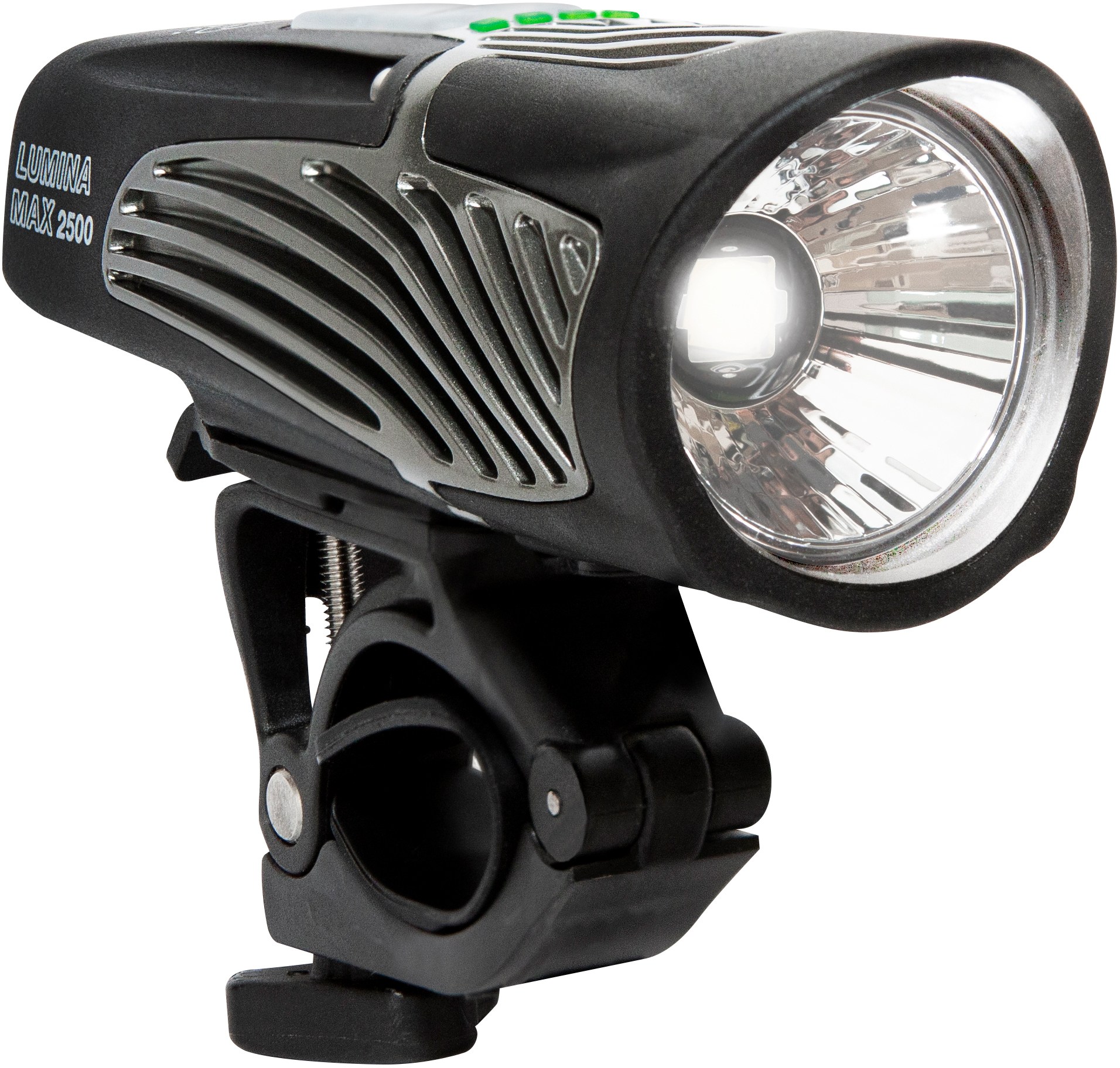 Type: Headlight
Type: Headlight
Max lumens: 2,500
Run time: 1.5–6.1 hours
What we like: A brightness and tech upgrade from the 1000 Boost above.
What we don’t: Expensive and short battery life.
NiteRider’s Lumina 1000 Boost above is a reliable no-frills light for the common cyclist, but those looking for a bit more tech (and brightness) should consider the Max 2500 here. The Max 2500 more than doubles the lumen output of the 1000 Boost, and it features five solid brightness levels and three flash patterns (compared to the Boost’s six solid modes). And rather than a single button for toggling, the Max has brighter and dimmer buttons for easy on-the-go adjustments. The Max also features NiteRider’s NiteLink which allows riders to remotely control a compatible taillight (such as the Omega 330 Evo).
That said, we can’t help but feel that the Max 2500 is a bit expensive for what it is. If we’re sticking to the road and the occasional trail, the Trek Ion Pro above is more than enough light for $60 less. And the Outbound Lighting Detour offers a more thoughtful interface and superior optics for $15 less. And if we want a more powerful light, we’ll opt for the Trail Evo for $45 more. All of these options boast significantly better run times than the Max 2500, which is dismally capped at just over six hours on the lowest setting. And like most of NiteRider’s options, the Max’s design feels outdated, especially compared to the more minimalist options here.
See the NiteRider Lumina Max 2500
 Type: Rear light
Type: Rear light
Max lumens: 65
Run time: 6–16 hours
What we like: Its unique radar system provides tangible safety benefits.
What we don’t: Pricey and not ideal for congested city use.
We’ll start by acknowledging the Varia RTL515’s price: $200 is a lot to spend on what looks like a simple tail light. However, this little Garmin is anything but simple. Hidden away is an innovative radar system that alerts you to oncoming vehicles from up to 150 yards. The rear unit pairs with a bike computer, smartphone, or sport watch and works fairly seamlessly: Once a car is detected, there’s an audible beep, and you’ll see a moving dot on the display (the dot is color-coded to indicate how fast the vehicle is approaching). The tail light itself is a solid performer with a bright flash mode, reasonably long run time, and a wide, 220-degree visible range. If you're willing to spend even more, you can invest in the Varia RCT715, which tacks on a camera that will record the goings-on behind you for even more security.
The Varia’s detection system excels on rural road rides or in areas without too much traffic, but falls short for city use. The sheer number of vehicles coming and going means that the radar and corresponding dot display won’t provide much useful information. As such, most commuters will want to steer clear, but the Garmin provides tangible safety benefits in the right circumstances. On the other hand, this rear light is too much tech for the casual peddler, and those who stick to mellow rides or short commutes can save a lot by going with the simpler rear light options on this list. But for the dedicated road cyclist, the Garmin really can’t be beat, and we’ve heard from a number of people that “it’s the best rear light I never knew I needed.”
See the Garmin Varia RTL515
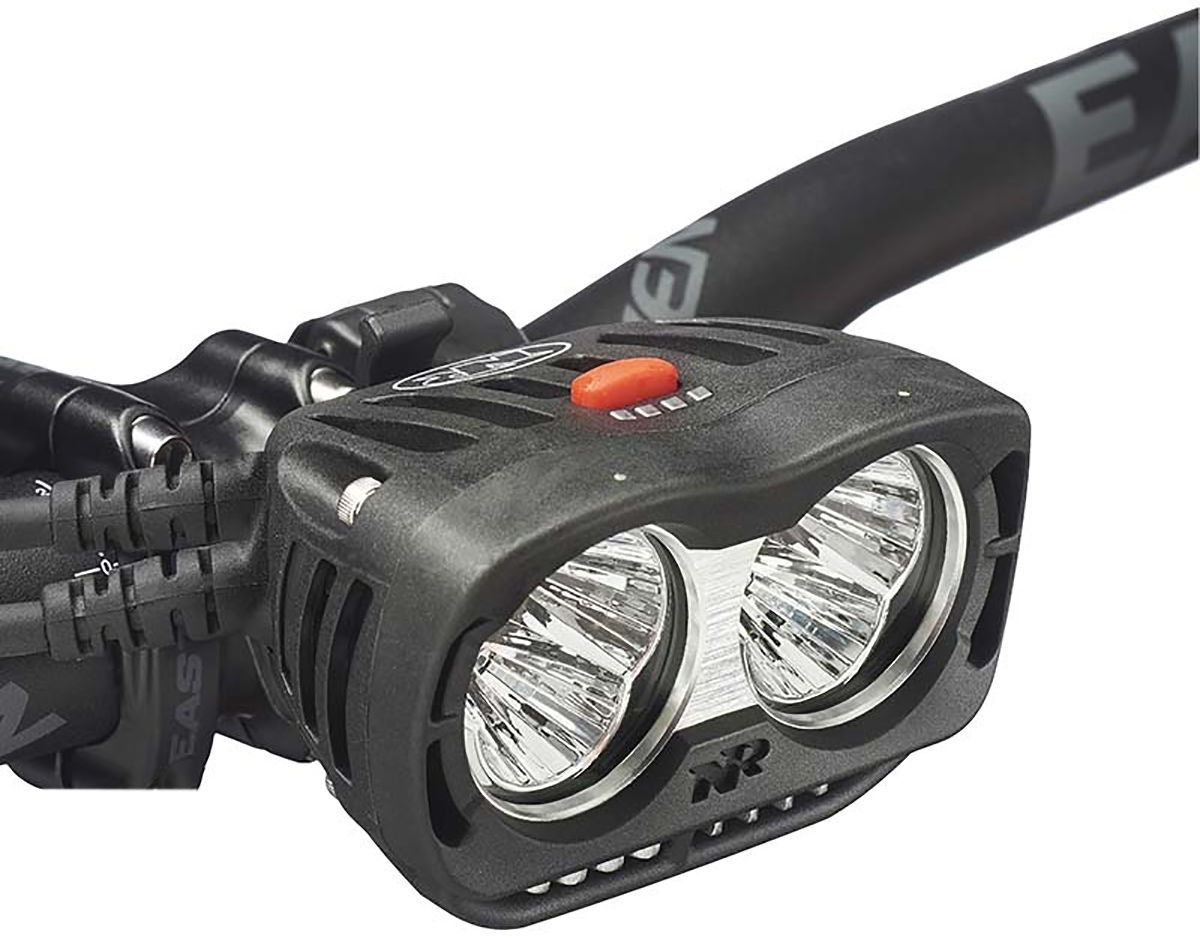 Type: Headlight
Type: Headlight
Max lumens: 4,200
Run time: 1.5–16.5 hours
What we like: Outstanding light output, solid track record, and long battery life on 1,000-lumen setting.
What we don’t: Very expensive, outdated styling, and bulky.
Packing a scorching light output but still offering surprising versatility is NiteRider’s Pro 4200 Enduro. The top-end model’s 4,200-lumen beam is certainly its main talking (or bragging) point, which will more than meet the needs of any high-speed nighttime mountain biker. However, we also like this light for its ability to produce 1,000 lumens for up to six hours, making it a great 24-hour race companion. Our mountain bike tester also really enjoyed the thumb controller, which allowed him to easily switch between brightnesses mid-ride. As with other premium lights, the Pro 4200 includes a rock-solid handlebar mount and a storage bag to keep everything in order.
Not surprisingly, considering its power and features, the NiteRider Pro 4200 is the most expensive model on this list. For a significant drop in price—as well as brightness—NiteRider also offers the Pro 2200 for $350. On the other hand, dedicated endurance riders can get a massive boost in output and battery life by spending up for Exposure’s Six Pack MK14 (5,800 lumens and 36-hour max life for $535). The Exposure also has a cleaner aesthetic and more durable build, giving the Pro 4200’s outdated design a run for its money. In fact, we found the Pro 4200’s handlebar mount to be especially clunky, and the pass-through wire system was tough to secure out of the way. At the end of the day, most singletrack users won’t be able to justify the investment of the Pro 4200 Enduro, but for racers or those who get out a lot and want a high-performance light, the Pro 4200 is a compelling option.
See the NiteRider Pro 4200 Enduro
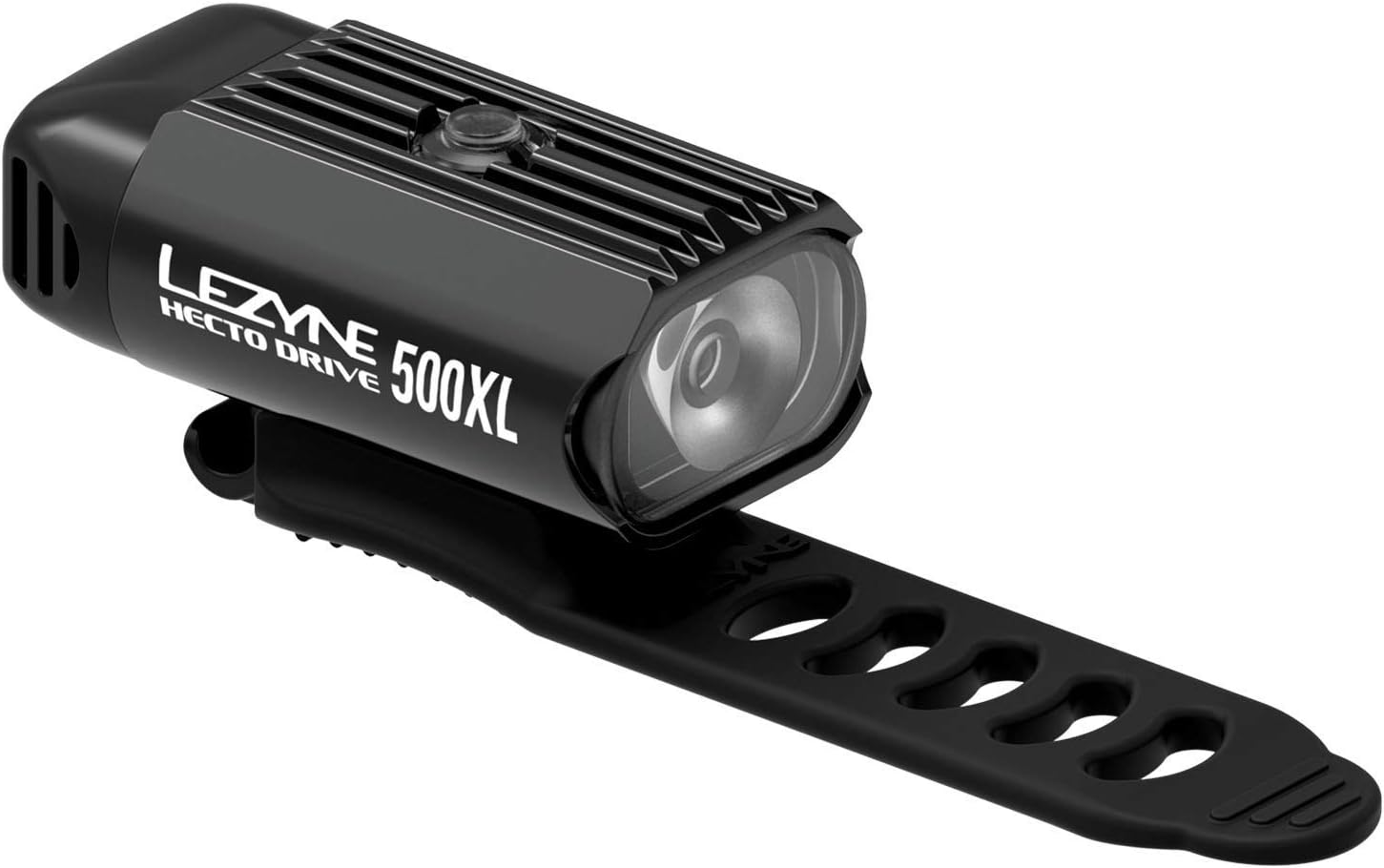 Type: Headlight
Type: Headlight
Max lumens: 500
Run time: 1-20 hours
What we like: Cheap option for road riding and commuting.
What we don’t: Short battery life and narrow beam.
Lezyne is a California-based company that has been producing quality bike accessories for over a decade. Their Hecto Drive 500XL headlight is a lightweight and durable choice for road riding and commuting. The 500-lumen output beam provides more than enough light for after-work commutes, and the handlebar attachment strap makes it easy to take the light off and stow it in your pocket when hitting the grocery store on your way home. This light has eight different light modes and is rechargeable via USB. And at just $45, the Hecto Drive 500XL gives our favorite budget light, the Swift 500.
Like the Swift 500 above, the Lezyne isn’t the ideal choice for pitch-black rides. Though its lowest brightness setting can last up to 20 hours, 15 lumens doesn’t do much at night. On the other end, while you get a respectable 500 lumens on the brightest setting, it’ll only last you about an hour on a full charge. We also aren’t the biggest fans of the narrow beam, but for $45, we can’t really complain. If anything, this is a great backup light that can live in your biking backpack for when you really need it.
See the Lezyne Hecto Drive 500XL
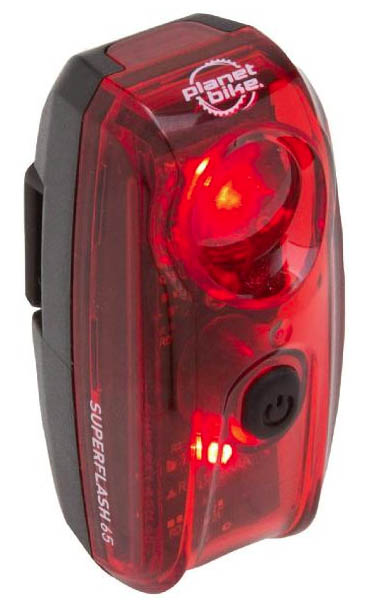 Type: Rear light
Type: Rear light
Max lumens: 65
Run time: 40–130 hours
What we like: A very economical way to boost safety.
What we don’t: Runs on replaceable batteries.
Putting no-nonsense functionality above all else is Planet Bike’s Superflash 65 rear light. The design is among the most popular on the market because it covers all the basics: 220 degrees of visibility, bright 65-lumen output on the most powerful flash mode, and a lightweight and compact design that’s easy to mount. It falls a little short in features—we’d prefer a dedicated randomized flash mode for daytime use like you get with the Cygolite Hotshot Pro and Knog Blinder above—but we like that it’s water-resistant and easy for motorists to locate in low-light situations.
The biggest downside of the Superflash is that it doesn’t have rechargeable batteries. Instead, the light runs on two AAAs that don’t have an exceptionally long run time (minimum of 40 hours), which means you’ll want to haul around spare batteries during your rides. In the end, the Superflash is a great budget option, but the stronger all-around performance and rechargeable batteries that come with the Knog and Cyloglite options give them the edge in the end.
See the Planet Bike Superflash 65
| Light | Price | Type | Max Lumens | Run Time (Hours)* | Best Use |
|---|---|---|---|---|---|
| Trek Ion Pro RT | $140 | Headlight | 1,300 | 1.5-22 | Road/MTB |
| NiteRider Swift 500 | $40 | Headlight | 500 | 1.8-32 | Road |
| Knog Blinder Link | $60 | Headlight | 100 | 5-50 | Road |
| NR Lumina Micro & Vmax | $105 | Set | 900 front, 150 rear | 2-60 front, 5.5-27.5 rear | Road |
| OL Evo Downhill | $375 | Set | 2,200 front, 1,000 helmet | 1.7-10 front, 1.1-6.5 helmet | MTB |
| Gloworm X2 Adventure | $269 | Headlight | 2,000 | 2-8 | MTB |
| NiteRider Lumina Pro 1000 | $105 | Headlight | 1,000 | 1-26 | Road/MTB |
| Exposure Diablo Sync MK5 | $325 | Headlight | 2,000 | 1-18 | MTB |
| Cygolite Hotshot Pro 200 | $50 | Rear light | 200 | 2-210 | Road |
| Outbound Lighting Detour | $185 | Headlight | 1,200 | 1.7-10 | Road |
| Cygolite Dash Pro & Hotrod | $95 | Set | 600 front, 50 rear | 1-70 front, 1.5-100 rear | Road |
| NR Lumina Max 2500 | $200 | Headlight | 2,500 | 1.5-6.1 | Road/MTB |
| Garmin Varia RTL515 | $200 | Rear light | 65 | 6-16 | Road |
| NiteRider Pro 4200 Enduro | $450 | Headlight | 4,200 | 1.5-16.5 | MTB |
| Lezyne Hecto Drive 500XL | $45 | Headlight | 500 | 1-20 | Road |
| Planet Bike Superflash 65 | $23 | Rear light | 65 | 40-130 | Road |
*Editor's note: "Run Time" refers to hours of run time per light, from minimum time at max output to maximum time on the lowest setting.
The staff at Switchback Travel is no stranger to the saddle: We’ve been known to take our townies out on sunny summer spins, send it down steep and gnarly trails, and even embark on an epic bike pack through remote Mongolia. This list of favorite bike lights has been a collaborative effort among Switchback staff since 2019, beginning with 17 lights picked by our bike-savvy former editor-in-chief, John Ellings, along with the help of experienced freelancers. Editor Maddie Downie and contributor Paul Kalifatidi took on the guide in 2024. Both Maddie and Paul are based in the bike-enthusiastic town of Bellingham, Washington and enjoy peddling in their own ways: Paul on the muddy single-tracks at Galbraith Mountain and Maddie on the streets and mellow gravel trails.
Though small and often overshadowed by “more fun” biking gear like backpacks and shoes, having a reliable bike light is essential to seeing and being seen on the trail or road. Whether you're looking for a simple light that can illuminate your commute to and from work or a burly design that can keep up with your post-work trail rides, this list runs the gamut and includes our go-to's for all kinds of riders. When taking these lights for a spin, we're sure to take notes on all the important details, from optics quality and brightness settings to battery life and charge time. We also care about their user-friendliness— both mid-ride and after dismount— and that they hold up for all your future jaunts. We're always keeping our eye on the market for any new or updated models that pique our interest, so we'll be sure to update this list when we find a new favorite.
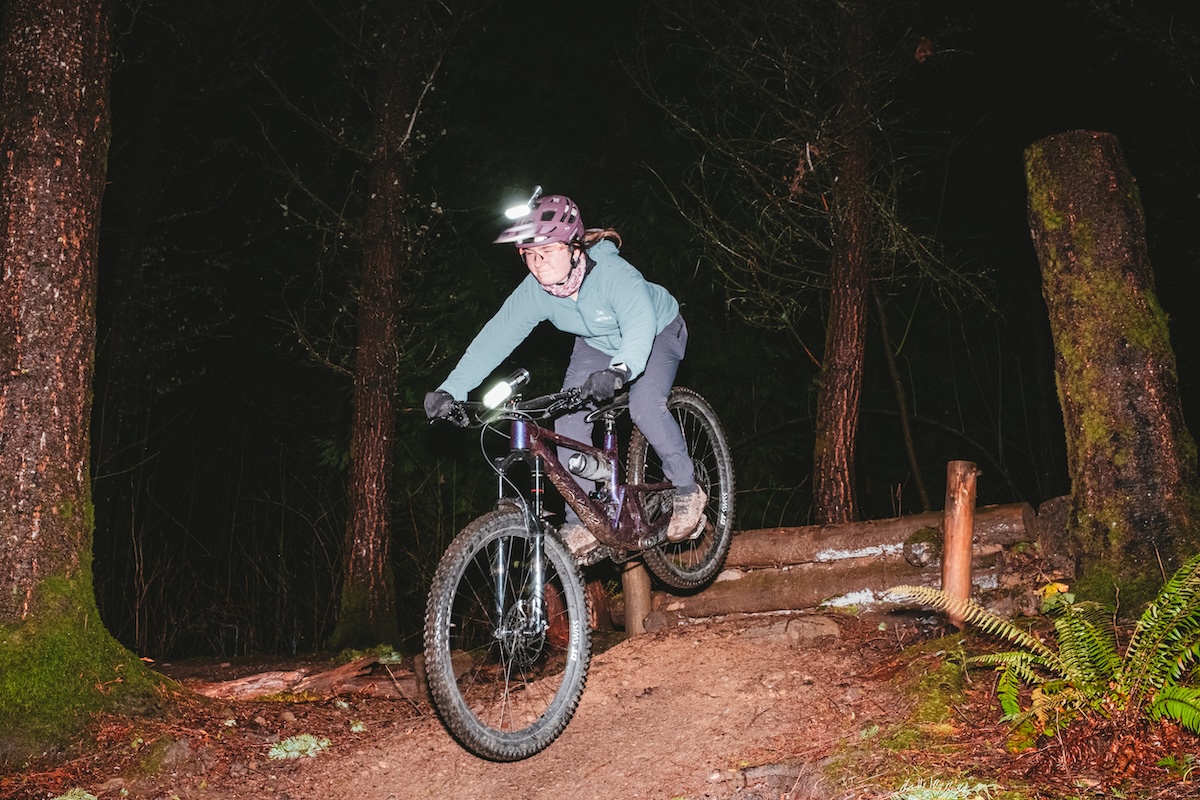
Headlights
When talking about lights for nighttime road and mountain bike use, the first thing that probably comes to mind is a headlight. These attach to your bike’s handlebar or helmet and have a simple function: illuminate what’s in front of you. Styles vary widely from 2,000-lumen torches designed for fast-moving, technical mountain biking (Gloworm’s X2 Adventure) to modest 300 to 500-lumen models for commuting at dawn and dusk (NiteRider’s Swift 500), but all of the picks above are battery-powered, include a variety of brightness modes, and offer some level of weather protection. Our top-rated light, the Trek Ion Pro RT, hits a great middle ground for both on- and off-road riding.
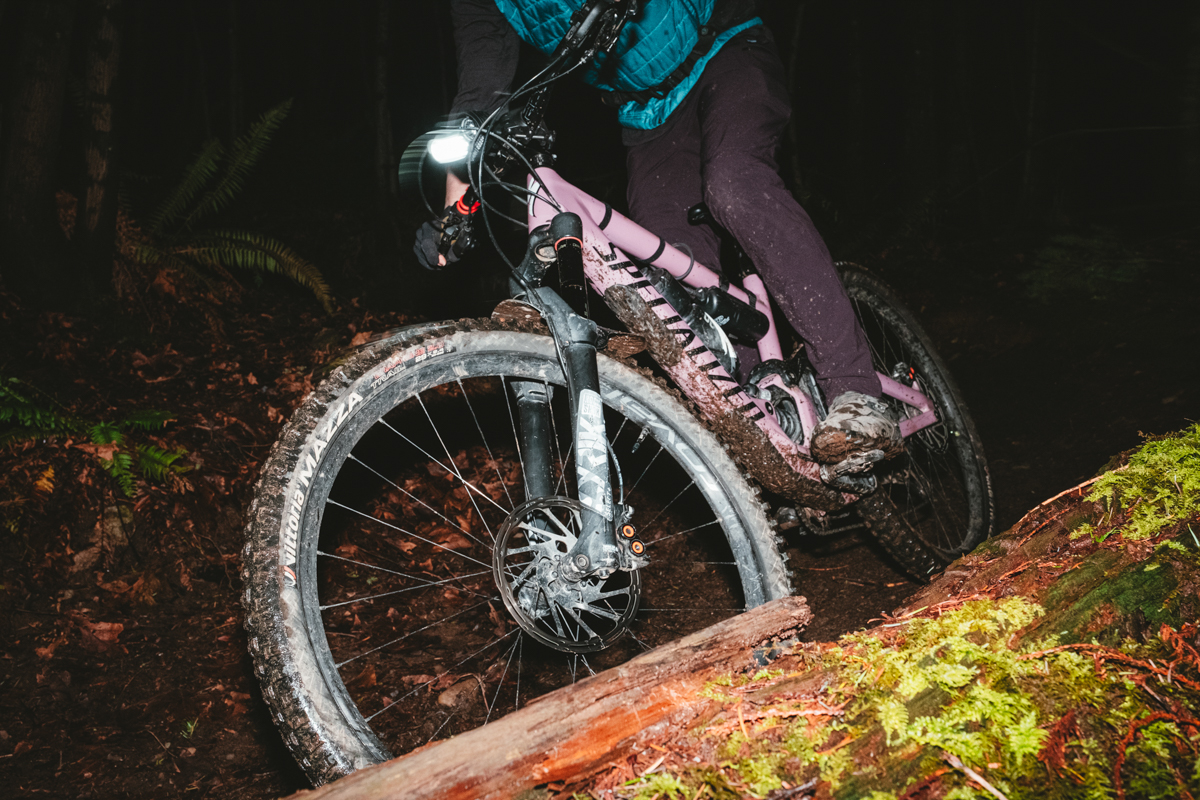
Rear Lights (Tail Lights)
For commuters and road riders alike, we strongly advise the use of a rear light, both during the day and at night. Also known as tail lights, these designs are relatively inexpensive, help draw the attention of motorists with bright, focused red beams, and are typically simple to mount. We recommend looking for models that are visible from the side for cross traffic (you’ll occasionally see references to “degrees of visibility”) and include multiple brightness and flashing modes. Tail lights typically are mounted on one of four places: a helmet, your backpack, the seat post of your bike, or your bike’s seat stay. We’ve found that the rear light that best balances price and performance for day and nighttime use is the Knog Blinder Link, with Cygolite’s Hotshot Pro 200 not far behind.
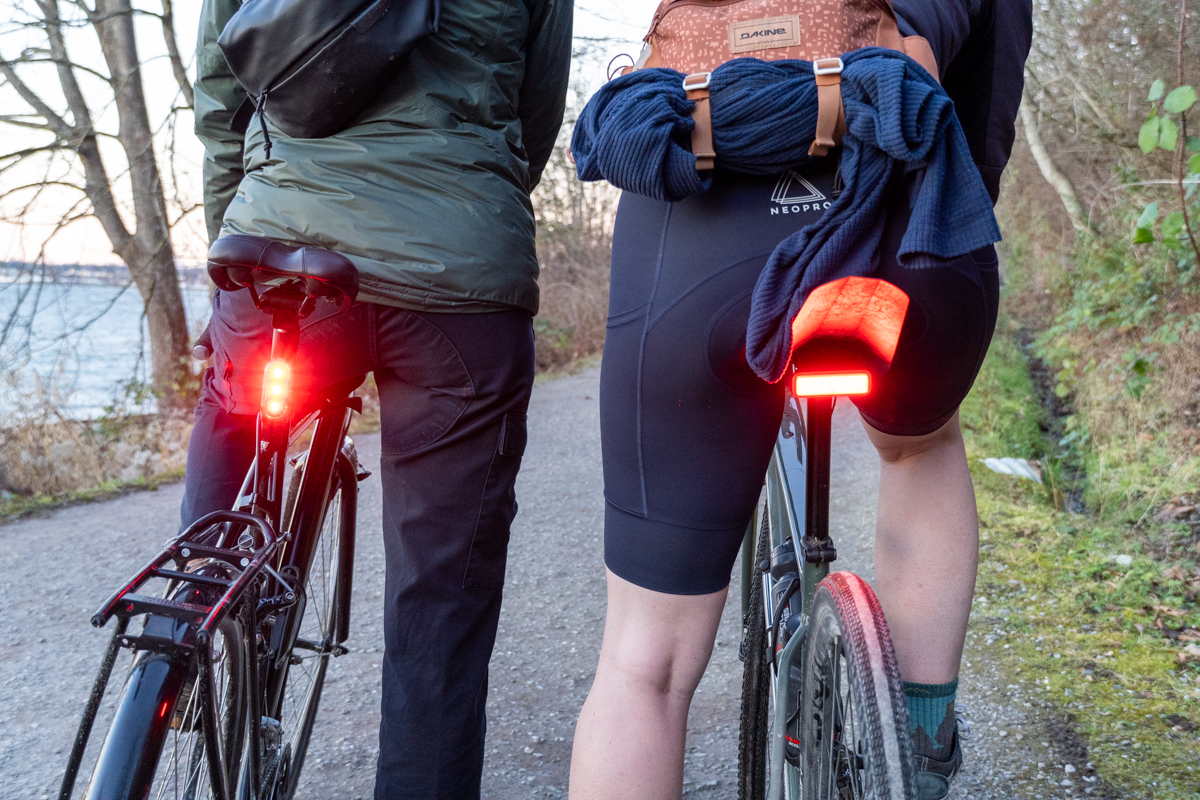
Combo Light Sets
For first-time light buyers or budget seekers who need both a headlight and rear light, a combo set makes a lot of sense. Manufacturers typically combine some of their most popular models, such as NiteRider’s Lumina Micro and Vmax+ set, and package them together at a small discount (in the case of NiteRider, you save $15 by purchasing the set). In the case of mountain biking, some manufacturers combine dedicated handlebar and helmet lights, like Outbound Lighting's Evo Downhill Package (which includes their Trail Evo headlight and Hangover Helmet light). This helps take some of the guesswork out of the process, although the preselected kits do limit the total number of available options.
Lumens, which are a measurement of visible light, provide an important indicator of the brightness of a given bike light. It’s not a perfect science—beam quality and pattern play a significant role in light performance—but determining approximately how many lumens you need is a good way of narrowing down your headlight and/or rear light choices. Starting with headlights and on-road use, we recommend urban commuters or low-speed road riders get a quality design with at least 500 lumens. You can certainly manage with less if you don’t need to illuminate a dark path, but we’ve found that options around 500 lumens (like the NiteRider Swift 500) are just powerful enough to allow you to confidently navigate city streets. That said, should your local nighttime commute or road ride take you through rural areas in complete darkness or down fast descents, it’s a good idea to bump up to more powerful options, like the NiteRider Lumina 1000 Boost.
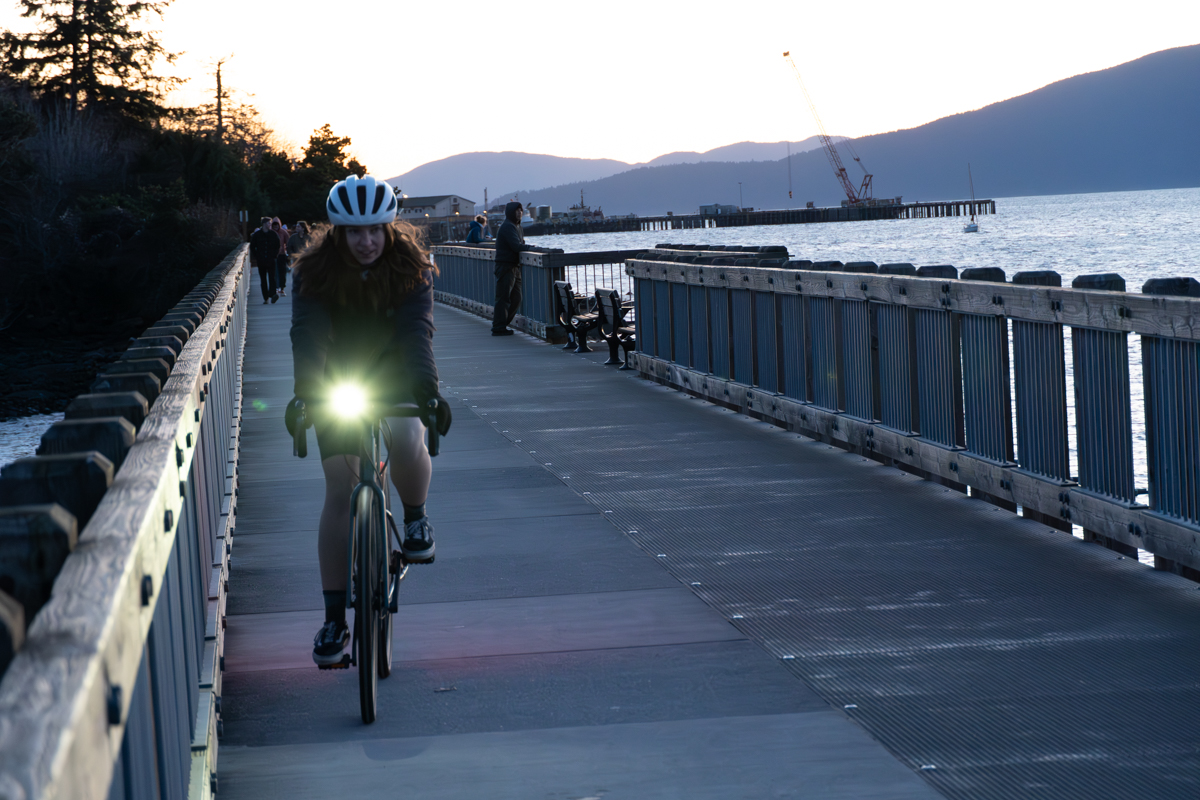
Riding a mountain bike at night on root- and rock-infested trails poses different challenges (and consequences) than a paved road or bike path. As such, we recommend a headlight with a high lumen output and strongly advise running two lights—one on the handlebars and the other on your helmet—to minimize shadows. In terms of lumens, it’s best to start in the 800 to 1,000 range. And those who want to cover ground quickly will want to step up to a model like the NiteRider Pro 4200 Enduro or Exposure Diablo Sync MK5. The high-output numbers may seem excessive, but we’ve never found ourselves wishing we were running them on lower power.
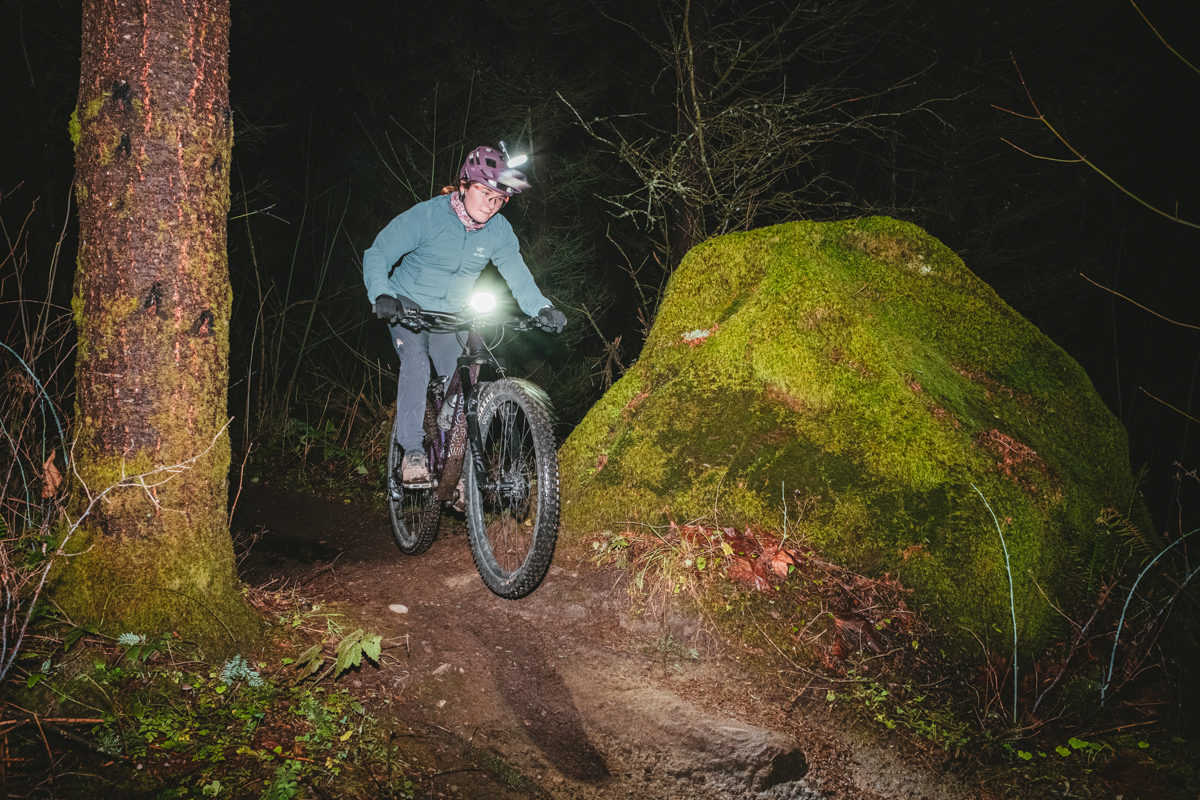
Headlight lumens get most of the attention, but a bright rear light offers significant safety benefits too. Quality tail lights with lumens in the 50 to 150 range can be seen from over a mile away, which can greatly reduce the potential of an accident. To further increase visibility for both day and nighttime riding, many rear lights offer their strongest outputs in flash mode (more on this in “Light Modes” below). Cygolite's Hotshot Pro 200 is a great example of a well-designed model: Its 200-lumen flash mode is the brightest of all the rear lights on this list, and an extra wide beam ensures vehicles will see you from afar.
Spot
Along with lumens, a headlight’s beam pattern is a key performance indicator. In general, bike lights fall into two basic categories—spot and flood—although there are a number of models that blend the characteristics of the two. Spot-style lights have a focused, small-diameter beam (commonly between 17 and 20 degrees) that projects very well over a long distance. This makes them a favorite among commuters and road riders, and for times when high speeds are attained. For mountain biking, we prefer mounting a spot-patterned light on our helmet for fast descents, as its extended beam allows you to easily look through turns. From our picks above, NiteRider's Lumina 1000 Boost is a great spot-oriented light for on-road use, while mounting the Exposure Diablo Sync MK5 on a mountain bike helmet is a proven choice for singletrack riders.
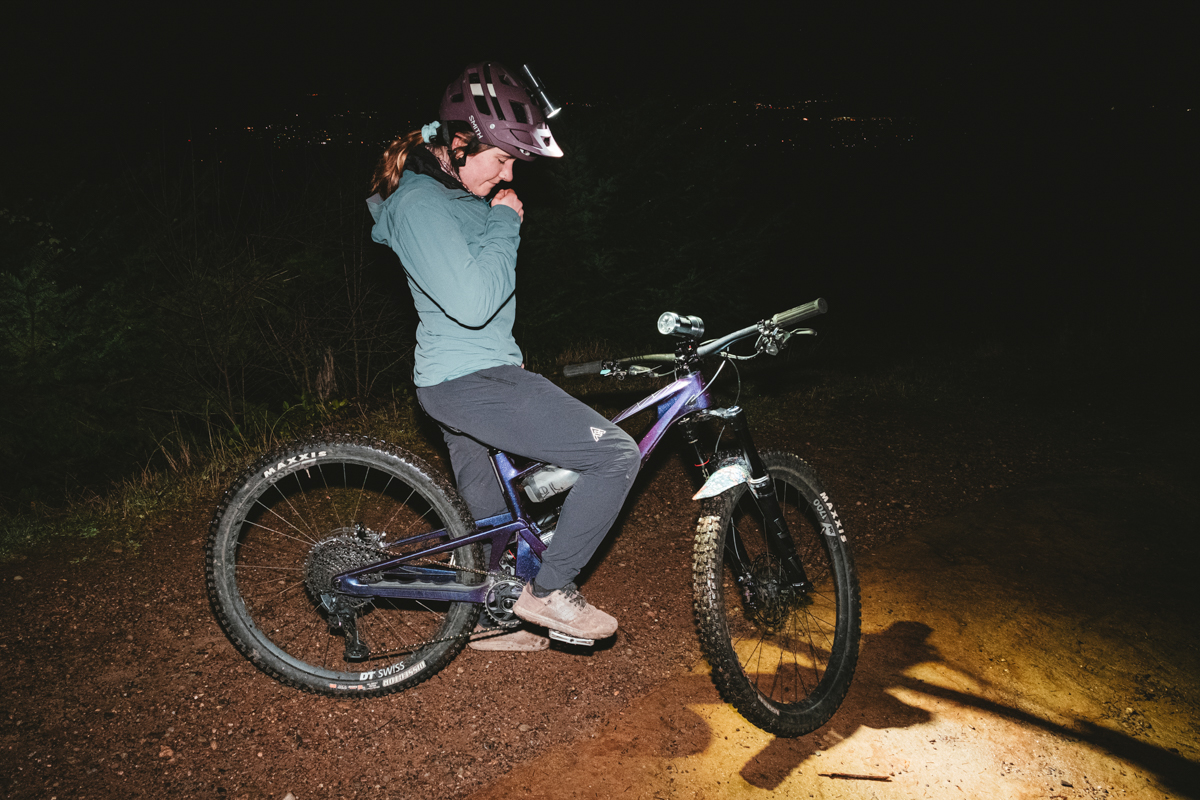
Flood
Flood lights illuminate a wide area in front of your bike and typically feature beam patterns in the 25- to 35-degree range. Although they may not project as far down the road as spot patterns, they’re a great match for low-speed riding and where wide visibility is more important than outright distance. These characteristics work well with handlebar mounts and pair nicely with casual urban riding. And for mountain biking, mounting a flood-pattern light on your handlebars to complement the spot-pattern helmet mount gives you excellent coverage. If you're looking to invest in both, consider Outbound Lighting's Evo Downhill set, which combines the wide-beam Trail Evo front light with the tighter beam of the Hangover helmet light in a trail-ready package.
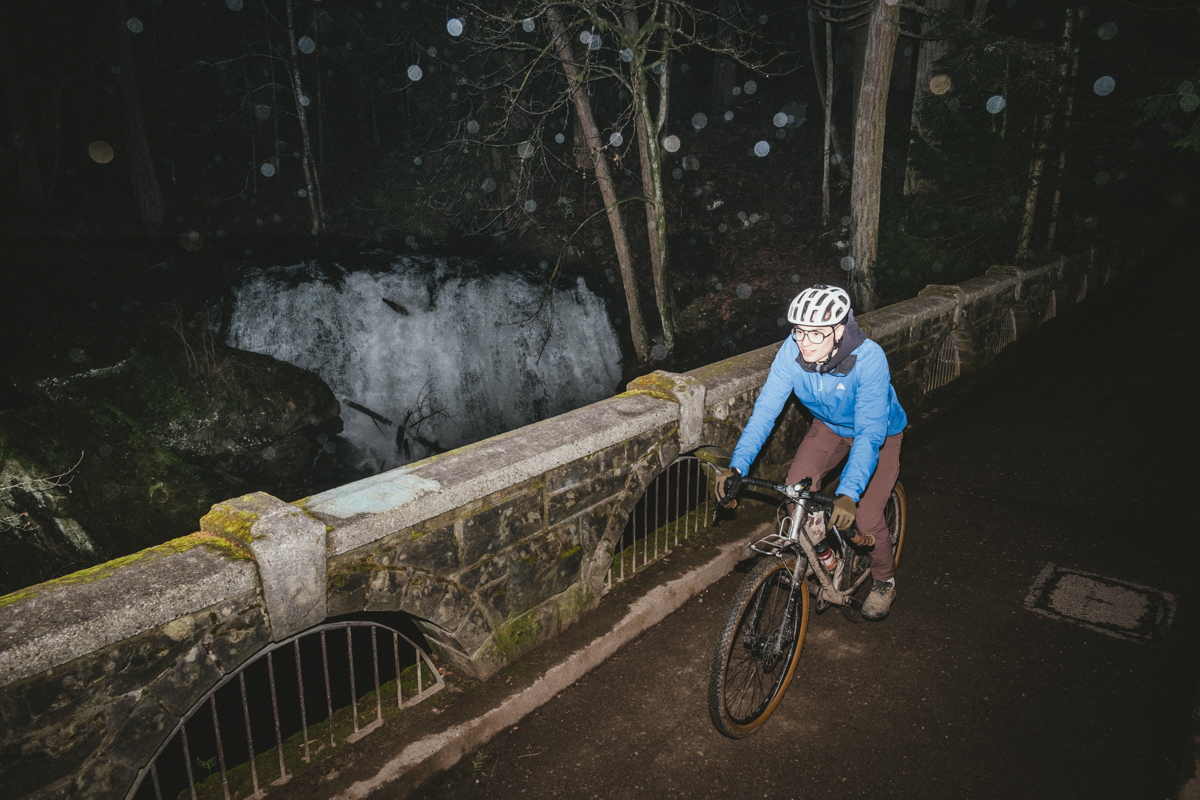
Every front and rear light that made our list above includes some level of adjustability between various light modes. Headlights, in their most basic form, typically have low, medium, and high settings that are controlled either directly on the unit or via a separate remote. Consciously switching between brightness modes to match your needs is a great way to prolong battery life. For example, when mountain biking at night, we like to put the light on the lowest setting during sustained, low-speed climbs. And when speeds pick up in flowy or downhill sections, we swap to medium or full power. In addition to brightness modes, road- and commuter-oriented lights will include some sort of flash setting. The pulsing pattern helps make you more visible to traffic ahead of you—even in daylight—while also greatly increasing battery life compared with a steady light.
Rear lights also come with a range of modes, although the level of adjustability is usually less than a comparable headlight. The big focus here is on grabbing the attention of cars, so popular designs like the Knog Blinder Link and NiteRider's Vmax+ 150 come with at least one flash pattern as well as a solid red light. As we’ve touched on above, using the brightest flash mode for daytime use is a worthwhile safety measure.
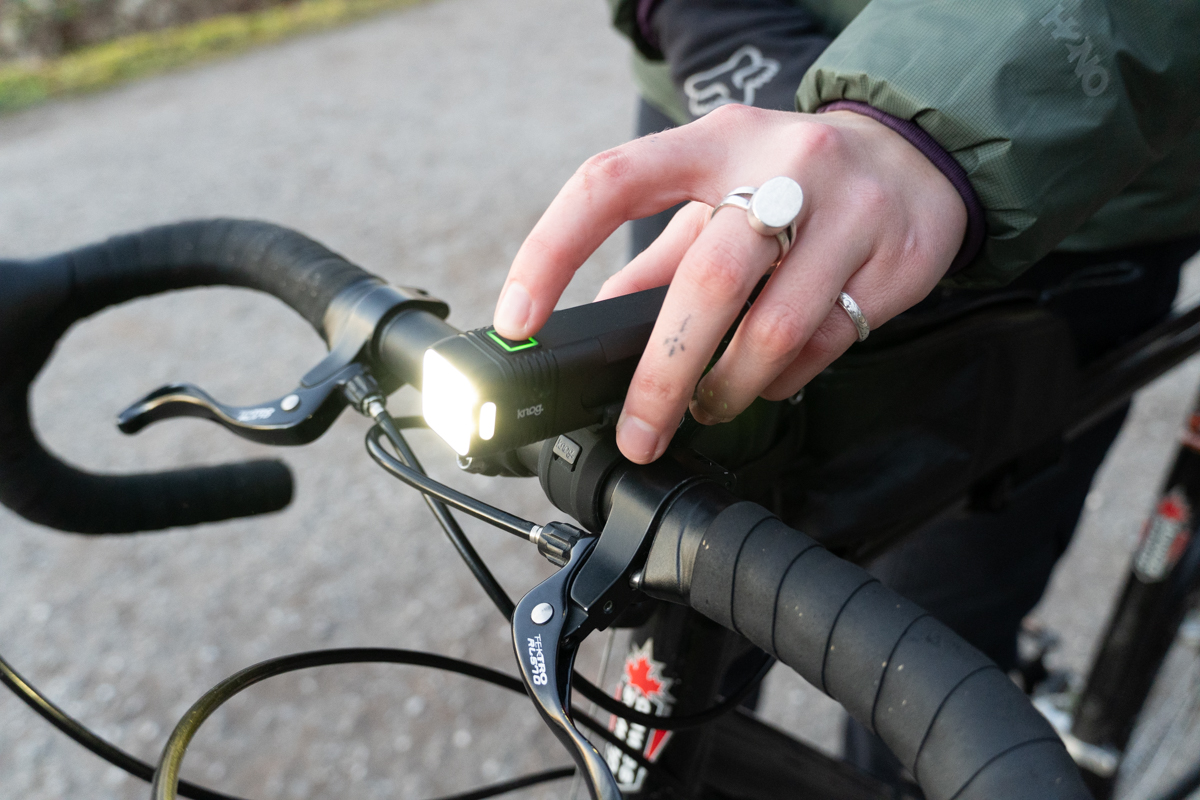
Regardless of total output, you’ll find that most rechargeable headlights and rear lights have similar minimum run times of about 1 to 2 hours when pumping out maximum lumens. For most urban riders, this should be more than enough for early-morning or late-night commutes and may even last a couple of days before charging is needed. However, mountain bikers will need to pay attention to this number a little more closely, as many rides can last longer than 1.5 hours (and sometimes not on purpose). Most headlights come with multiple brightness settings, and this is where battery life starts to differ between models. On their lowest settings, run times vary from 5 to 11 hours among our top picks. Furthermore, some models like the NiteRider Lumina 100 Boost come with a very low lumen “walk mode,” which extends the battery life to 21 hours in the Boost’s case. Although not very useful for riding, its 50-lumen output is enough to guide you in an emergency situation.
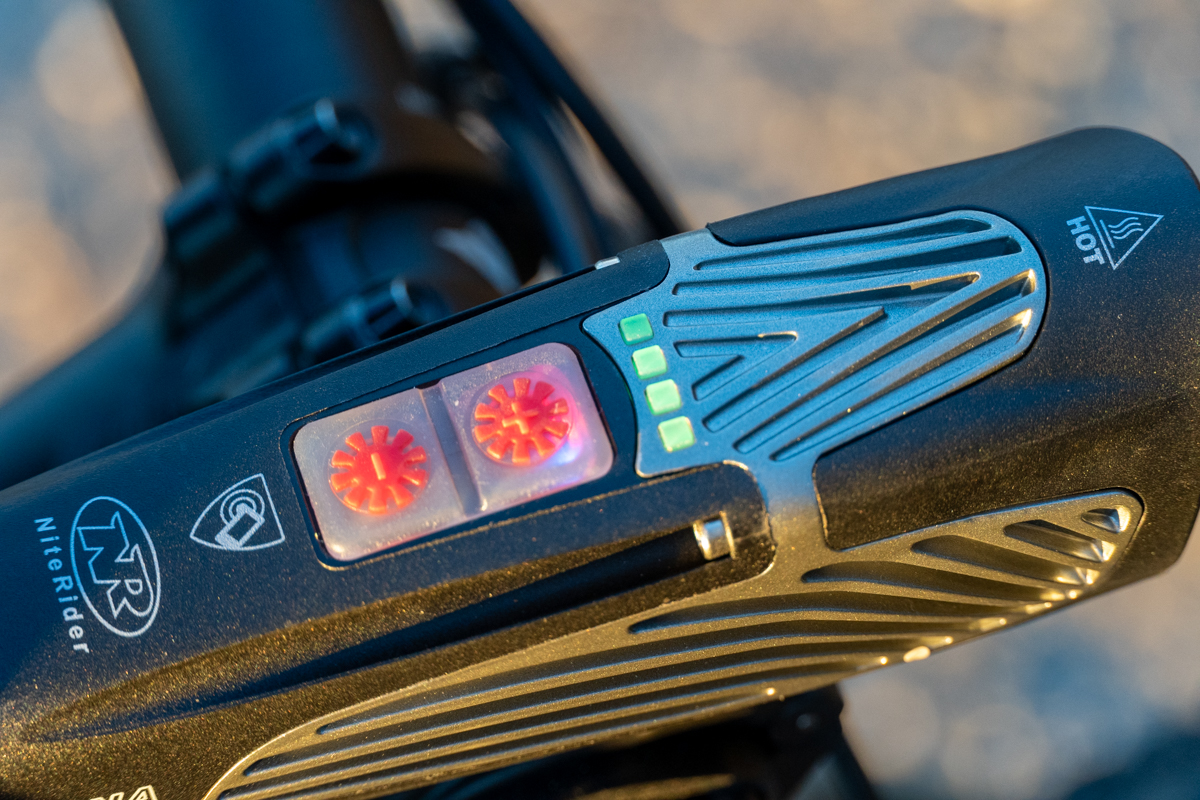
Another way to extend battery life is to purchase a light with a higher output than you actually need. While the extra lumens will likely be welcome, using the light on its low and middle settings (rather than high) will greatly increase the time between charges. For instance, the NiteRider Lumina Max 2500 is a very bright light at its highest setting (2,500 lumens) and probably beyond what most people require. However, on its medium setting of 900 lumens, which is more than enough for climbing singletrack or low-speed commutes, it extends the battery life to 3 hours (from 1.5 hours on its max setting). Should you plan to be out in the dark for two or more hours, it’s worth considering upping your lumen output just so you can run it in the middle or low setting for increased battery life.
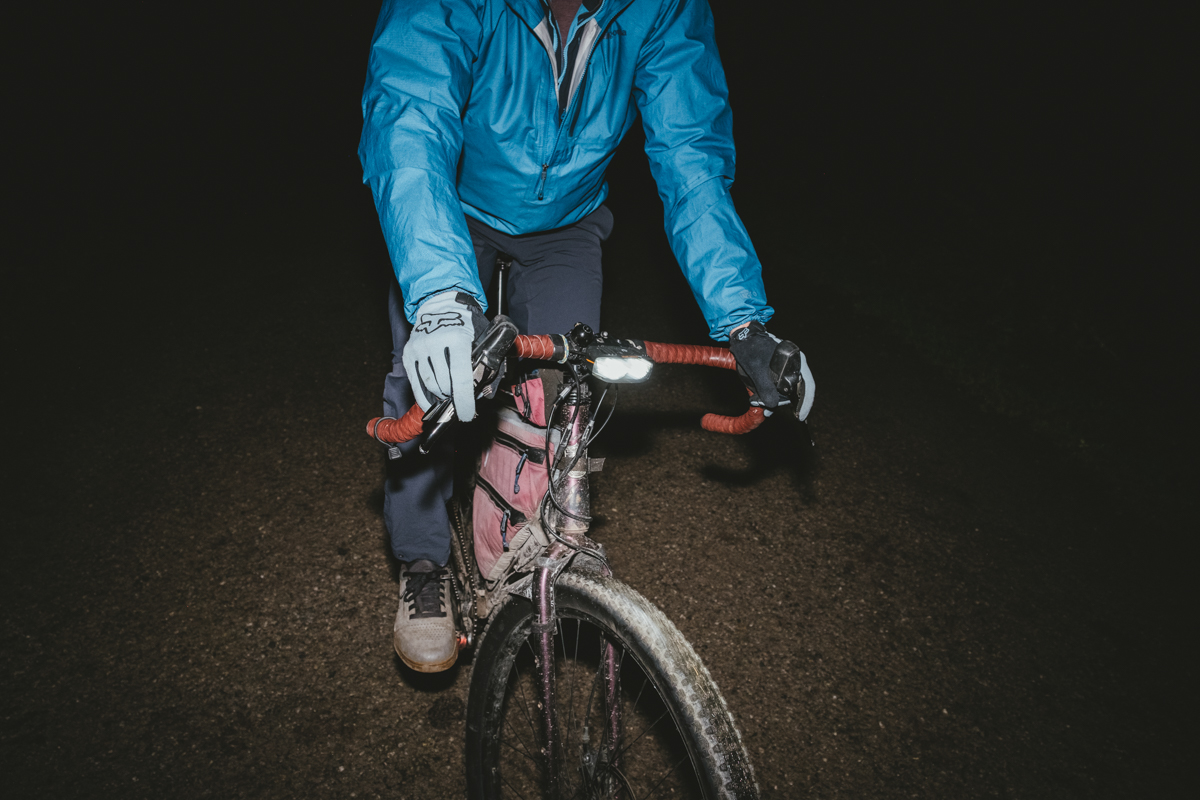
Headlights
Typically, bike headlights are mounted in one of two locations: on your handlebars or on your helmet. Mounting a light on your bars is quick, and adjusting the beam’s location on the road or trail is easy. We find this location to work particularly well for commuting by bike, as you rarely need to look around corners and make quick changes in direction. While a light mounted on the handlebars is perfectly fine for road riding, we prefer a light on our helmet for mountain biking at night. With the light attached to your head, the beam follows your eyes as you look up and down the trail. For the best of both worlds for mountain biking, we recommend mounting a light on both your handlebars and helmet. This helps eliminate any shadows that are often caused by a single light.
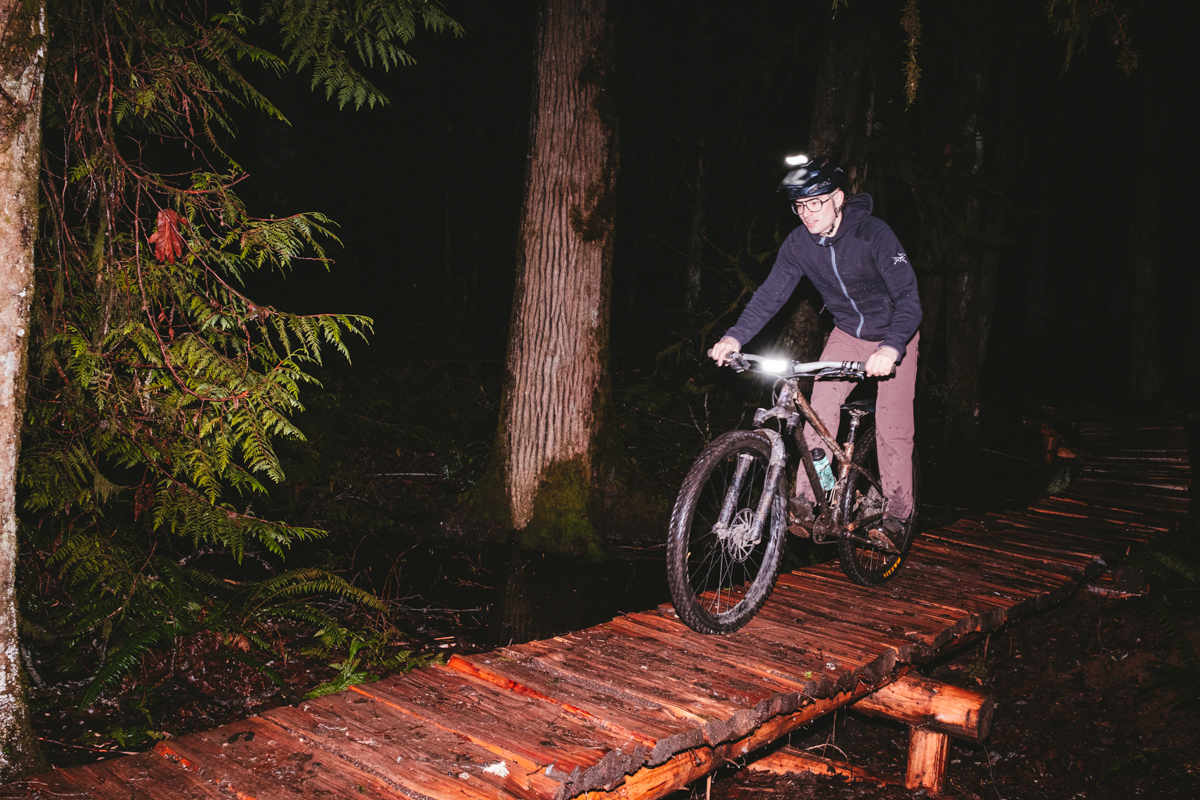
Rear Lights
The most common place to mount a rear light is on your bike’s seat post right under the saddle. Located here, the light’s beam is rarely obstructed by the rider or bike, providing good rearward and side-to-side visibility. Other popular mounting locations include the back of a helmet, your backpack, and the bike’s seat stay. While all of these options are viable, we’ve found the seat post offers the most effective way of grabbing the attention of approaching motorists. With that said, it’s not uncommon to have multiple tail lights for urban use, so the other locations can function well as a complement to the seat post mount. In our opinion, anything a cyclist can do to be seen on the road—without blinding traffic or fellow riders—is worth it.
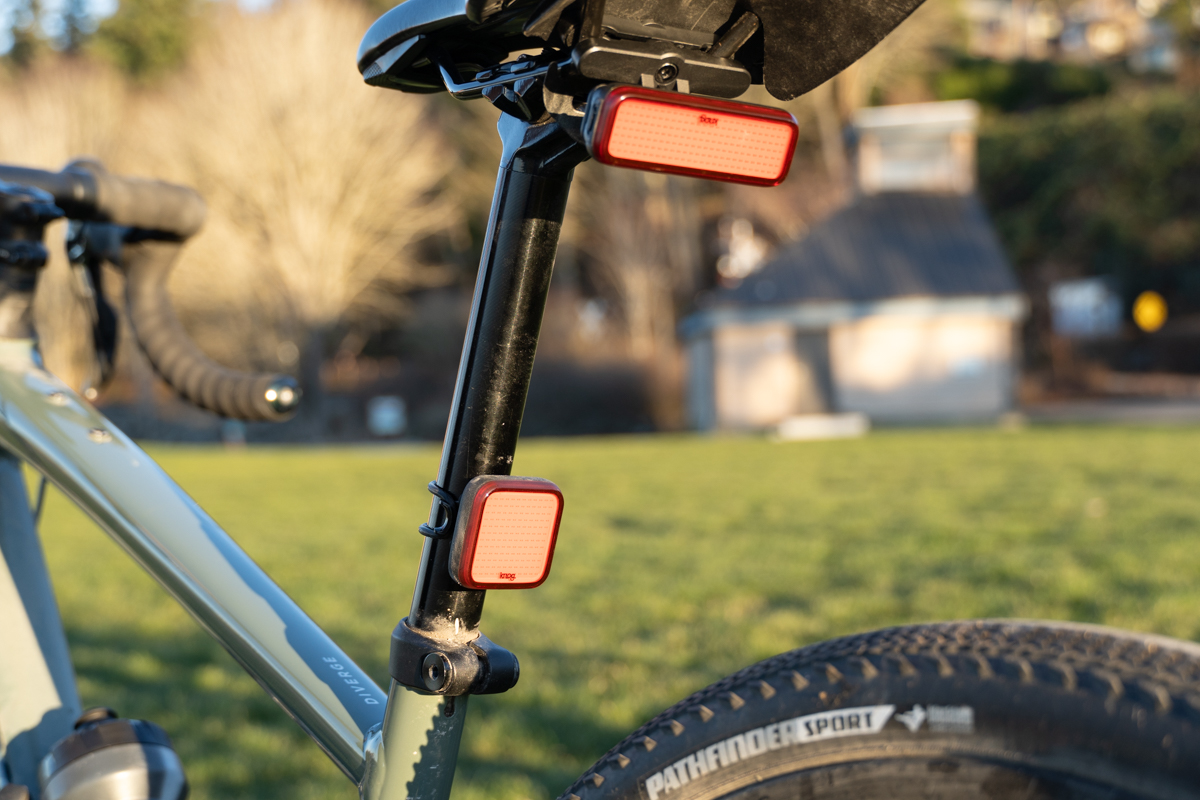
If you plan to get out on your bike at night, then there’s a good chance you’re becoming more serious about the sport. Accordingly, there’s an equally high likelihood that you’ll find yourself out riding in some inclement weather. The good news is that most quality lights on the market offer some level of water resistance, often listed using the International Protection Rating (IP) system. Even moderately priced models, like the Gloworm X2 Adventure, carry an IP67 rating, which makes them waterproof at a depth of 1 meter of water for up to 30 minutes. More frugal designs compromise a little here, but the $40 NiteRider Swift 500 is a notable exception with its IP64 rating for protection against dust and water spray.
Overall, weight generally isn’t something to be too concerned about in a bike light, as your bike’s handlebars, seat post, or frame do most of the heavy lifting. However, it quickly becomes a top consideration if you’ll be mounting it on your helmet. There are few things more distracting than having what feels like a brick balancing on top of your head while bombing through technical terrain. If you’re looking for a high-output helmet light, we recommend something like Outbound Lighting's Hangover.
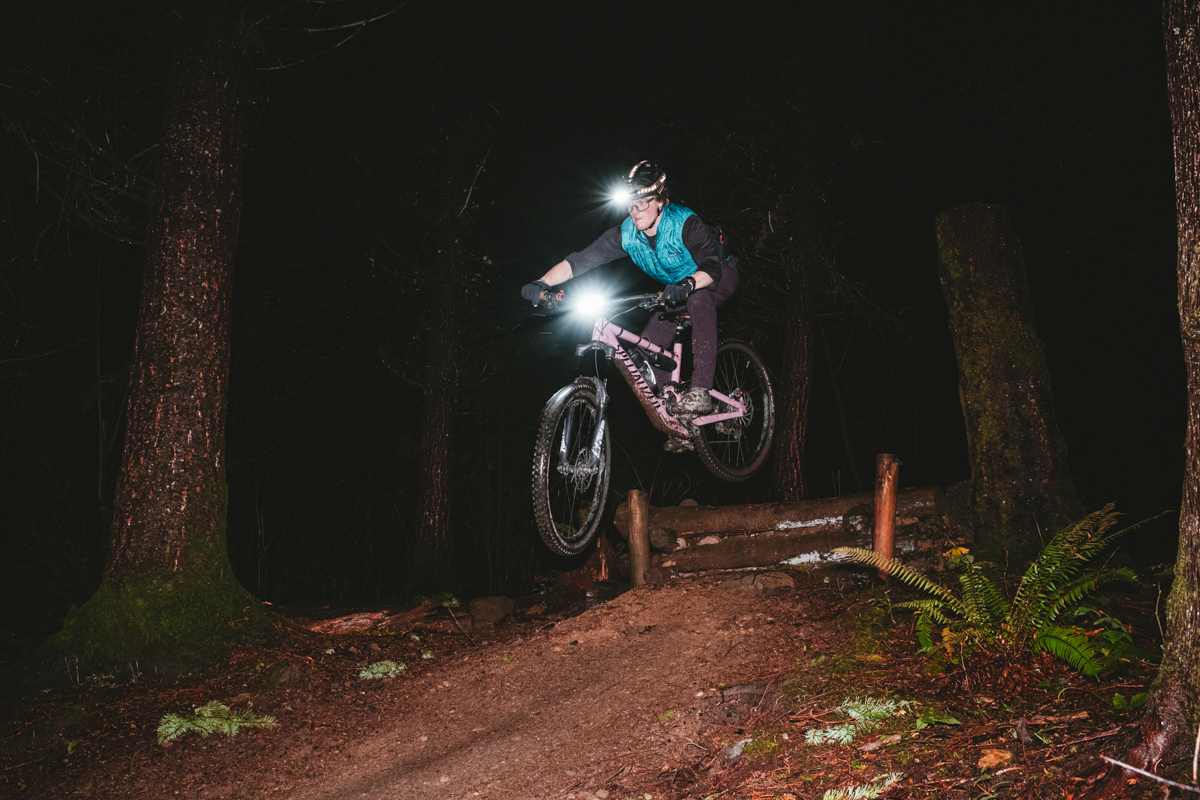
The majority of headlights and rear lights on the market today have an integrated design, which means the batteries and light are all housed in one unit. This style is reasonably compact and easy to set up and mount onto your bike or helmet (with the proper attachments). The main downside to integrated batteries, however, is that the cramped space inside the unit puts limitations on battery power. As such, integrated battery lights do not have very long run times and are not able to support exceptionally high-output designs, like anything above about 2,500 lumens.
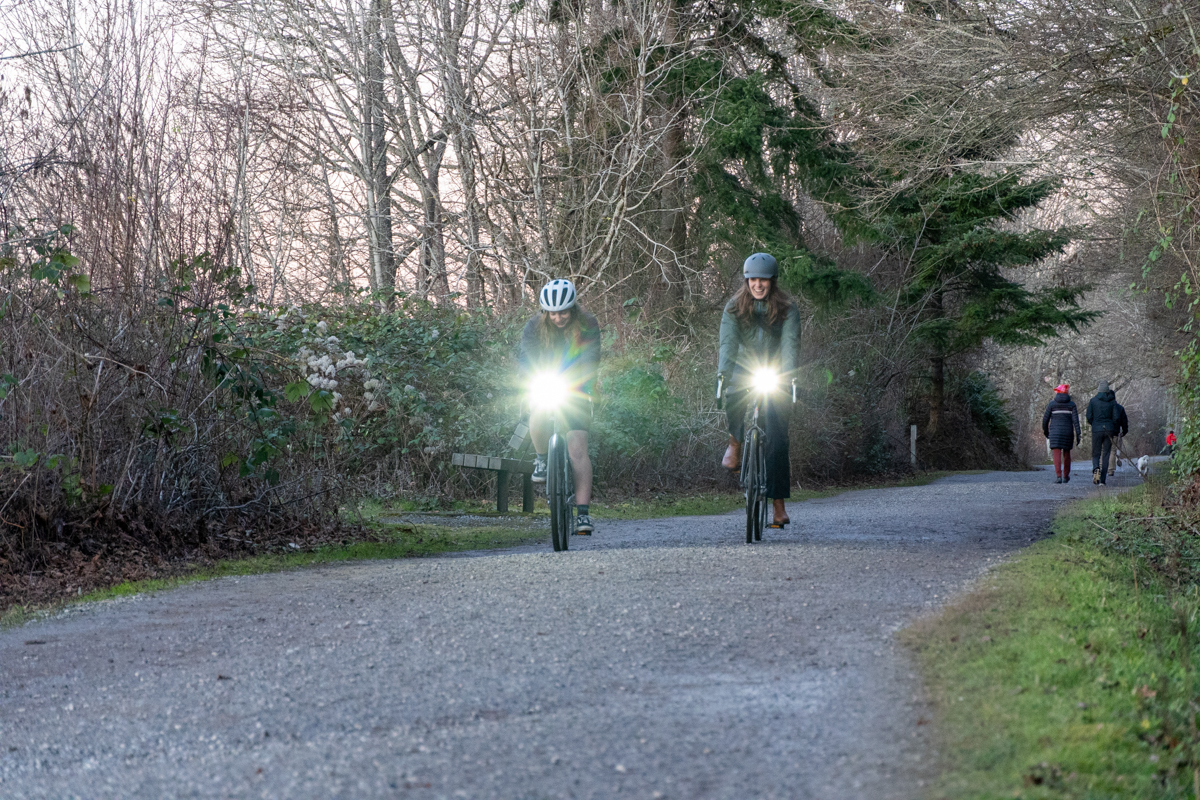
Enter external battery lights. These styles, like NiteRider's Pro 4200 Enduro, are able to support very strong outputs with remarkable run times. The aforementioned NiteRider is able to use its 4,200-lumen light on high for 1.5 hours—something that’s typically not possible with integrated batteries. But like integrated systems, an external battery pack comes with its fair share of negatives. Most notably, these lights are typically quite heavy. They’re also a little cumbersome to set up and use because of the multiple parts (head unit, cable, and battery pack). That said, if you want to maximize light output, you’ll most likely end up with an external-battery model.
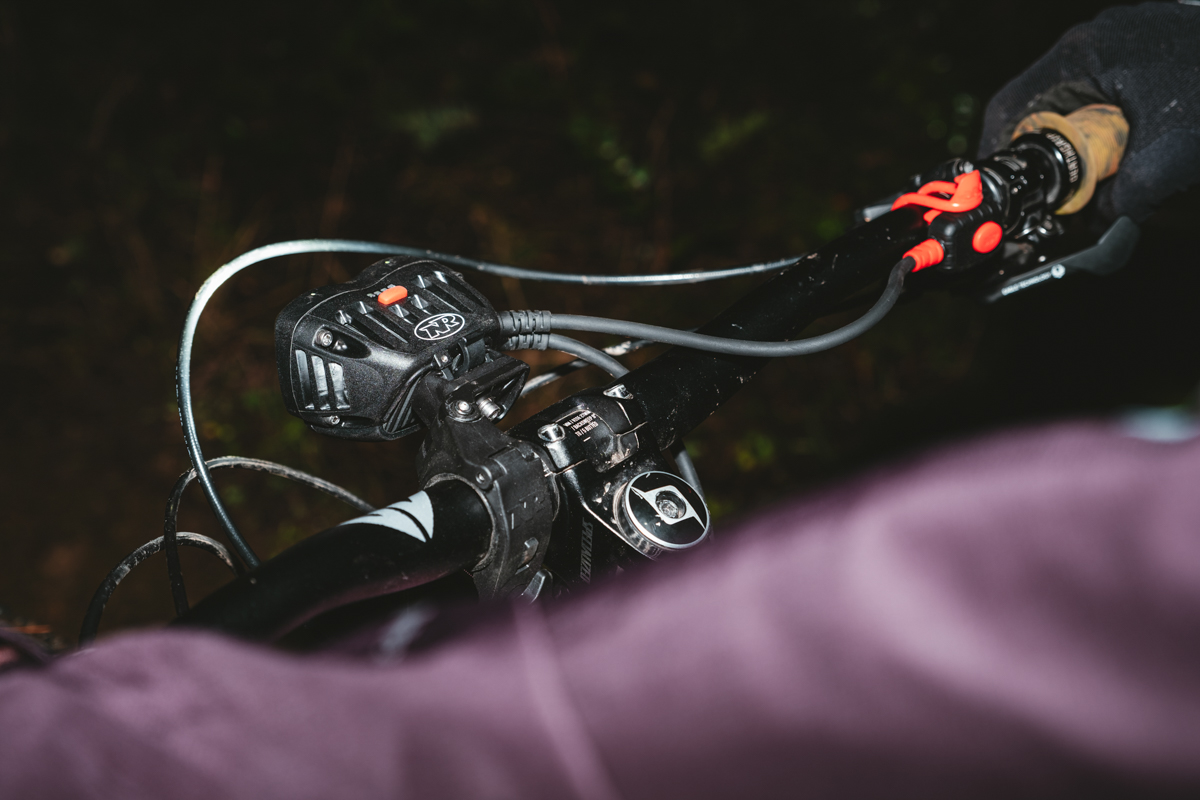
For the occasional nighttime mountain biker, where frequency is low and planning ahead is easy, your battery’s charge times aren’t all that important. However, for bike commuters, this can be a key specification. And charge times can vary widely: Our top pick, Trek’s Ion Pro RT, has a very long charge time that ranges from 7 to 15 hours. This means you’d likely need to get it plugged in right away as you arrive at work to get it back to full power in time for the ride home. On the other hand, NiteRider’s Lumina Micro 900 and Vmax+ 150 Set (our top pick for bike commuters) can be fully charged in as little as 2.5 hours. If your workdays are short and your commutes are long (everyone should be so lucky), then a quick charge time is something to be aware of.
While not necessary, remote control of your light—via a physical switch on the handlebar or Bluetooth connection that pairs with a bike computer—can be a helpful feature in certain situations. Wireless handlebar-mounted remotes, like the one on NiteRider Pro 4200 Enduro, are great for mountain biking as they allow you to keep both hands on the grips while switching through different brightness modes. Other models, like Garmin's Varia RTL515, connect via Bluetooth to a compatible cycling computer or smartphone and allow you to change modes and keep tabs on battery life. This means you don’t need to jump off your bike if you want to adjust between flash settings or constantly check behind to see if it’s still working. The Varia is also unique in its radar system, which can detect vehicles from behind and alert your bike computer as they approach. All in all, while not a top consideration, remote connections are a nice luxury item with plenty of appeal for those who ride a lot.
.jpg)
If you get far enough into bike light research, you’ll inevitably run into someone recommending inexpensive “Amazon” or “eBay” lights. While they certainly look like a great deal on paper, these products come with a number of downsides. First off, we find their lumen ratings to be somewhat misleading: The 1,000-lumen light selling for $25 will fall well short of NiteRider's Lumina 1000 Boost in every possible performance metric. A big part of this comes down to lens quality, which determines how the light is cast on the path or trail—it’s similar to comparing a $10 pair of gas station sunglasses to the $100 option from Smith or Oakley. Last but certainly not least, the batteries in cheap lights will typically not have the same lifespan as the quality options listed above, and it’s common for run times to significantly drop after a year or less of use. In the end, with excellent designs like the NiteRider Swift 500 available for $40, we see little reason to save a few dollars for an inferior and unreliable product.
Back to Our Top Bike Light Picks Back to Our Bike Light Comparison Table